- Yachting World
- Digital Edition


Review: Silent 55, the extraordinary solar powered yacht
- January 18, 2019
Silent Yachts is tapping into the solar zeitgeist and creating a new meaning for the term ‘powercat’. Sam Fortescue reports

There is a slow, silent revolution under way in the yachting world. It is a revolution that is introducing tonnes of lithium and a sprinkling of silicon to the spec list of new boats. Holding out the promise of silent mobility, plus limitless domestic power on board, it made a big splash at the last Cannes Festival of Yachting – not least thanks to the new Silent 55 catamaran which debuted there.
From the pontoon side, the Silent 55 looks like a typical modern catamaran, with a big coachroof studded with windows and a flybridge helm. Except there’s no mast. Now, bear with me here. I realise that this is a sailing magazine, but we will shortly get back to more familiar territory. The unique qualities of this catamaran only become apparent from up top, where an expanse of solar panels stretches away fore and aft, embedded into the coachroof. The hard top itself carries yet more panels, and can be folded down flush to give an unshaded solar array of 49m2. During the heat of a summer day in the Med, this is capable of generating 10kW of power and up to around 60kWh in the course of the day.

But to make a solar system work in reality, Köhler had to go back to the drawing board on yacht design. The saloon and hulls have extra thermal insulation to keep air-con losses down, and the use of carbon and aramid in key areas helps reduce the overall weight to a decent 17 tonnes (a Lagoon 52 weighs 22.5 tonnes). He has tried to keep windows out of the direct sun with long overhangs and in contrast to the Lagoon’s 12 deck hatches, the Silent 55 has just two.
Holistic design
On the other hand, it has lots of opening windows, to allow a natural draught to do its job. “It’s a holistic approach – you can’t take the batteries and the drivetrain and drop it into another boat.”
Of course, using the propulsion system quickly takes its toll of the boat’s 140kW battery bank. The model on display at Cannes had two 135kW motors, giving you just half an hour of silent motoring flat-out, albeit at a top speed of over 20 knots. More reasonable 30kW engines and a single-digit speed give you greater range. Nonetheless, the electric drive alone isn’t going to allow you to outrun a storm, or race home after a day at anchor, so the boat is designed to work with a generator hidden in the heavily insulated transom of its starboard hull. At cruising speed of around 5-6 knots, Köhler says there is rarely any need to use the generator, citing an owner who has just emailed him triumphantly about a second year totally generator-free. “In the end, you have to compare it to the performance of a sailing boat,” Köhler says. “It is as fast as a sailing boat in similar conditions – after all, there is no wind without sun.” He went so far as to tell me during the sea trial in Palma, Mallorca, that he believed the majority of sailors would happily dispense with the hassle of sails and a rig if only they could enjoy silent motoring and anchoring. “As soon as people realise the incredible concept of this boat, they won’t understand why they ever did anything else.”
The market does not seem to agree with him – yet. Sales of the boat have been good – they have already sold six, five of which are already in the water. But of those, four customers have taken the sail option, which means planting a 19.7m tall mast complete with boom and rigging slap bang in the middle of the coachroof solar array. “I was a bit amazed,” Köhler admits. “The shade from the rig reduces the energy generated by the solar area, while it costs more and is heavier, so consumes more fuel. Maybe it is for optical reasons.” In fact, the shade of the rig slashes the average yield of the solar panels in half. In the Med, that means around 30kWh per day. But perhaps it figures. The typical profile of buyers is an environmentalist who has a Tesla electric car and is “an early adopter who likes to have things before others”. And at low speeds, with modest use of the air-con, the reduced energy generation should still cover daily consumption.

The performance under sail should be reasonable because of the lightweight build of the boat, its broad 8.47m beam and stub keels added to each hull. Control lines are led back via conduits in the coachroof to the flybridge helm station, to make single-handing under sail a possibility.
More interesting, I think, is a sort of halfway-house option using a kite rig. This optimises the performance of the solar panels and gives plenty of propulsion. On the smaller 55 and the 64, Silent Yachts currently recommends a 19m2 kite that costs around €25,000 – a fraction of the cost of a new mast, boom, shrouds and sails. “The sail automatically makes a figure of eight above the boat, and you can steer it with a joystick or an app on an android phone,” Köhler explains. “It can propel the 55 at up to 6 knots, even in light winds.” Perfect for an Atlantic crossing, then.
For the bigger Silent 79, which will hit the water in the summer, a commercial grade Sky Sail system needs to be used – a smaller version of the ones used on cargo ships. This kite can propel the boat at ten knots, but it costs more than ten times as much as its smaller cousin. Both are capable of pulling the boat upwind. So far, so new. But outside the novel energy and propulsion system, the Silent 55 aims to do what many other cruising catamarans are trying to achieve. “Most of our clients order for circumnavigation and long-term cruising,” Köhler says. So the boat is aimed to be as comfortable and capable as possible with watermakers, TVs and an induction hob that all capitalise on the boat’s abundant energy. A flexible configuration allows owners the choice of between three and six cabins – the latter designed for charter. The owner’s cabin lies forward of the saloon, under the windows of the coachroof, which provide magnificent views and abundant natural light. There’s a walk-around bed and steps down into the starboard hull give access to an en-suite shower room and heads.

In my view, the best cabin lies aft of this, accessed in the traditional manner down steps out of the saloon. The king-sized bed lies athwartships and the shower is larger than that of the master cabin. There’s more space down here, better headroom and still plenty of light courtesy of the many hull lights.

When I had the chance to sea trial the Silent 55, albeit in motorboat format, I jumped at it. It was a contrary autumn day on Mallorca with 15 knots breeze – just a shame, then, that this wasn’t one of the sailing configured versions.
To start with, getting on board is made really easy courtesy of deep boarding platforms on the skirts. She feels rather square because of that vast, glazed saloon with its deep overhang, and perhaps because of the utilitarian nature of the hard top, which is really about supporting more solar panels. Nevertheless, the side decks are broad and uncluttered. The space up top is designed to concertina down flat, hence the hydraulic rams, fold-down seat back and lowering console. It makes a great sailing position, though, with all round visibility, and is also perfect for sundowners at anchor. When the rain comes down, this feels quite exposed, but there is a fully sheltered helm at the front of the saloon, and it is also possible to drive the boat from anywhere using a tablet thanks to smart electronics. Under power, the handling is superb. The quietness of the motors is astonishing, and I gather they’ll be inaudible on the next boat, which will do away with the gearbox. Even in the aft cabins, directly above the motors, there is no more than a distant hum. The boat responds instantly to the power and the wind seemed to have no impact at all. As with any propulsion system, the power consumption jumps as you pile on the speed – it was sobering to see. At 6 knots, both motors drew 10kW but at 8 knots it was closer to 30kW. I liked the huge saloon with its raised table for 360º views. And the sliding door and window gives great access aft, connecting the saloon and cockpit in fine conditions. The finish was smart and in muted tones, feeling more Scandinavian than German.
Intriguingly, at least it seems to me, Köhler has tapped into something with the concept behind Silent Yachts – but not entirely for the reasons that he expected. Buyers are opting for the sail or kite versions of the boat because they want a comfortable wind-powered craft with abundant, quiet energy on tap. It brings a whole new meaning to the term ‘powercat’

Multihulls: new yacht reviews
Yes, the racing world is stretching the boundaries, with 100ft foiling maxi trimarans tearing around the globe and F50s, the…

Multihulls: owners’ experiences and reviews
They have two different boats, different sailing plans and two very different sets of experience. But what these cruisers have…

- Green Propulsion
- Renewable Energy
- Energy efficiency
- Sustainable materials
- Eco Insights
- News & Events
- Sunreef News Magazine
- Press About Sunreef

- 60 Sunreef Power
- 70 Sunreef Power
- 80 Sunreef Power
- 100 Sunreef Power
- Sunreef Supreme Power
- Sunreef Ultima Range
- Sunreef 44 Ultima
- Sunreef 55 Ultima
- Sunreef 66 Ultima
- Sunreef 77 Ultima
- Sunreef 88 Ultima
- Sunreef fleet

- Sunreef Zero Cat
- Sunreef 100
- Sunreef Fleet

- Sunreef 35M
- Sunreef 43M
- 49M Sunreef Power
- 210 Sunreef Power Trimaran
- Sunreef Explorer
- 40M Sunreef Explorer
- 40M Sunreef Explorer Eco
- 50M Sunreef Explorer
- Superyachts Fleet
Recharge at Sea: Solar Catamarans Harness Sun-Powered Serenity

Just as a residential solar system makes a house independent of an electricity grid, a marine solar panel makes a yacht independent of a fossil fuel powered generator. Catamarans boosted by solar power systems are increasingly in demand in today’s day and age for their increased energy efficiency and reduced environmental impact.
Here is everything you should know about solar catamarans from Sunreef Yachts Eco :
An Introduction to Solar Catamarans
Derived from natural sources, renewable energy is replenished at a far higher rate than consumed. Of these, solar energy is the most abundant renewable energy resource on Earth that may even be harnessed during cloudy weathers. Additionally, because sunlight remains omnipresent, powering a watercraft with solar energy is a fitting concept.
Before we continue exploring the subject of solar catamarans, let us focus on the architecture. The twin hull structure of catamarans translates into a large beam, which provides ample space for solar panels installation. To top it off, catamarans have a fairly shallow draft that produces little to no drag, making them exceptionally energy efficient .
Marine solar panels are currently gaining substantial popularity amongst catamaran designers and manufacturers as a medium of supplying clean energy via a reliable source. Sunreef Yachts Eco is a pioneer in solar catamarans as we believe that the incorporation of a solar power system into yachts births an environmentally friendly yachting solution with a significantly reduced carbon footprint.
The Benefits of Solar Catamarans
The ocean is home to the largest continuous ecosystems; unfortunately, it also remains the most sensitive. Millions of people across the globe indulge in recreational marina and boating activities leaving behind pollution in their wake.
Here are three ways in which solar catamarans rectify commonly occurring hazards for the greater good of the environment:
1. Fuel (oil or gasoline) spills and the discharge of combusted fuels from engines readily contaminates water surrounding the marinas. This aggravates toxicity levels in water, resulting in increased pollutant concentrations in aquatic organisms and sediments.
For illustration, coral reefs, which are a vital source of nitrogen and nutrients for marine food chains and provide shelter for over one million aquatic species, are nearing extinction due to water pollution. Installing solar panels would, without a doubt, decrease the dependency of all types of watercrafts on non-renewable energy sources, i.e., fossil fuels, for operations and increase energy efficiency.
2. Noise from moving gas-powered ships cuts straight to the sea floor and back. These acoustic vibrations transmitting end-to-end affect marine animals to a great extent. Research suggests that human-caused noises result in disrupted behaviours, increased stress, and impaired feeding in marine life, leading to injury and death. Solar catamarans are far quieter than their combustion-driven counterparts; thus, they maintain the oceanic silence vital for the marine life as it enables communication and continuous growth.
3. The elimination of fuels also makes solar yachts more affordable to run and maintain in the long haul. In comparison to fuel powered generators, solar catamarans produce electricity at a lower cost since solar panels obtain power via the sunlight, a renewable source of energy that is present in abundance. But even if your catamaran utilizes both fuel and solar power, you are still to enjoy significant savings on fuel.
Why Power A Boat with Solar Panels
Apart from the obvious environmental factors, solar panels fulfil an important criterion for the oceangoing voyagers who do not wish to be left stranded far from land with a dead battery: unlimited backup power.
On a typical sailing day, there is ample sunlight to ensure the backup battery restores enough power to generate electricity that keeps motors, electrical systems, and onboard appliances running. An added benefit of solar panels is that they continue to generate power even when the catamaran is at a standstill. This energy is stored in batteries for later use.
Furthermore, unlike gas powered generators, solar catamarans do not produce excessive heat, are quieter, and experience little to no vibrations. This allows boat trips to remain pleasant for sailors and vacationers.
Sunreef Yachts combines luxury with sustainability to offer noiseless, vibration-free, and fume-free cruising experiences. Launched under the Sunreef Yachts Eco flag, our sailing and motor yachts are powered using inhouse engineered solar panels that are fully integrated within their composite structure for optimal results. However, an additional asset for sailing solar catamarans remains the ability to combine eco motoring with wind propulsion with the use of high-performance kites.
The Mechanism of the Solar Power System
Classification of solar panels .
There are various kinds of solar panels available for marine boats: adjustable panels, standard panels, and high-energy thin-film panels. While some may argue that having a portable solar panel makes it easier to relocate to where the sun shines the brightest, permanently mounted panels remain ready to go throughout the day.
Despite their long life, standard panels often fail to find a place in the marine industry as they compromise the space availability onboard. Hence, high-energy thin-film panels emerge as winners due to their ability of being permanently embedded on the solar catamaran’s bodywork without restricting living space.
The research and development team at Sunreef Yachts Eco developed the industry’s first composite integrated photovoltaic technology to produce highly efficient, shock resistant, flexible, and ultra-thin solar panels. This in-house engineered solar power system was recognized as a winner of the German Design Award 2022 in the category of Excellent Product Design: Eco Design .
Each solar panel consists of photovoltaic cells, compromising of a positive and negative layer for creating an electrical field. These are made of singly-crystal silicon, a semiconductor that absorbs the radiations of the sun to produce electrical power via the photovoltaic effect. For better understanding: the photovoltaic effect is the process of converting photons (a particle of light) to voltage.
Technical Specifications of Solar Panels
While the average solar panels’ weight lies between 8 to 15 kilograms per square meter, Sunreef Yachts Eco’s solar cells have a thickness below one millimetre and weigh only 1.8 kilograms per square meter. This makes Sunreef Yachts Eco the lightest marine solar power system producer in the solar catamaran market.
Each of the solar cells administered into the Sunreef solar catamarans are ISO 9001:2015 certified and offer a peak performance of ±24 percent, this is 25 to 30 percent more power compared to conventional cells. Despite this, these solar cells do not heat up excessively when receiving sunlight.
Integration Into the Solar Catamarans Structure
The orientation of the sun should be as such as that it hits the solar panels at a 90° angle for best performance. However, with the Earth rotating around its axis to produce a 24-hour day, it is non-viable to ensure the perfect angle throughout the day.
What is more is that the amount of energy produced may also differ depending on external factors, such as a building preventing direct sunlight from hitting the solar panels or light experiencing diffraction from the waterbody before contact. For this reason, it is best to invest in high-efficiency solar cells that generate maximum energy even from limited number of active panels.
Sunreef Yachts Eco makes the most of its solar catamarans’ space availability by spreading its “solar skin” across the hulls, mast, superstructure, bow terrace and bimini roof. Due to this arrangement, the solar panels receive ample sunlight at desired angles from early morning to late afternoon.
At the same time, light rays bouncing off the surface of water to the solar panels, in a process called reflection, also helps generate electricity. These superior performance solar panels possess great strength and durability to survive adverse conditions, year after year.
Generation of Electricity on Solar Catamarans
The crystals in marine solar cells are treated to enable the movement of electrons to generate an electric current. These silicon electrons activate only when in direct contact with sunrays. Instantaneously they start producing direct current (or DC) charges, which is captured by wires and stored in the batteries as energy.
At this point, a charge controller is employed as a regulator for the energy to transfer from the solar panels to the battery. It not only manages the energy load received by the battery, but also prolongs the battery life and performance by ensuring the battery is not overcharged or overloaded. Solar catamarans deploy multiple charge controllers depending on the energy produced.
While the current may be supplied directly to support the electrical demands of the catamaran, if the appliances demand alternating current (or AC), an inverter is added to the cycle to convert the DC to AC first.
Solar Catamarans in Action
But how much energy is enough energy? Working out a catamarans’ energy requirements requires summing up the energy consumed by each device onboard in watt-hours. For better understanding: energy is power accumulated over time, so if power is calculated in watts, energy is watt-hours.
Hence, the first step of installing solar panels dictates an extensive energy assessment of the watercraft. This requires checking the labels of every individual appliance onboard for its typical amp hours and volts used, be it the fridge, fan, or lightbulb. A battery monitor can also help measure energy consumed more accurately.
Depending on the size of the catamaran and the energy consumed, the solar panels size and wattage of power can be precisely determined. Multiple solar panels may be wired together to form a solar array for maximum energy generation. Aiming to fulfil the power needs of your catamaran with solar panels allows you to enjoy a quiet, peaceful anchorage.
Overcoming The Challenges of Solar Catamarans
While yacht solar panels resolve the problem for keeping the batteries topped up without running the generator, solar power systems are faced with challenges of their own. For starters, the harsh weather incurred at sea and saltwater splashing on or immersing the panels accounts for much damage.
However, technological advancements have enabled solar panels to withstand most of these environmental adversities. To illustrate, the installation and electronics linked with solar power systems have now become more resistant to short circuits and corrosion.
Sunreef Yachts Eco employs a unique photovoltaic integration technique in solar catamarans to give the panels extreme resistance to shock and abrasion. Even if the cell eventually cracks, the solid metal foundation remains intact to maintain a high-power output. Furthermore, these solar panels experience no light-induced degradation, no temperature coefficient, and favourable low-light and broad spectral response.
Likewise, the constrains of surface area for marine solar PVs have been addressed with the ability to manufacture customized solar panels. For instance, Sunreef Yachts Eco uses the lightest solar cells in the industry which offer unparalleled flexibility for placement on rounded surfaces of the solar catamaran while others break under pressure. Here solar panels are integrated vertically (on hull sides, flybridge sides, and mast) and horizontally (on front flybridge and bimini) to maximize energy generation.
While the Sunreef Yachts Eco’s solar panel system has a protracted life expectancy, any panels sustaining damage, due to adverse conditions at sea or other geographical circumstances, can easily be replaced. However, it is proven repeatedly that their performance remains unaltered over extended periods of time.
Efficiency of Solar Catamarans Vs. Diesel Yachts
Solar panels make for an ideal energy provider as they ensure the batteries always have power. This makes solar catamarans more self-sustainable and cost efficient to run in comparison to gas-powered ones. Additionally, fewer moving parts in solar catamarans call for significantly lesser maintenance in comparison to diesel yachts.
Boats of all shapes, sizes, and types (sail or motor) can be powered via solar energy to run all onboard appliances on battery. Apart from fulfilling the watercrafts’ day to day electrical usage, utilizing a renewable source of energy extends the durability and reliability of the catamaran.
But most importantly, a solar powered yacht compared to a standard diesel yacht has a significantly reduced carbon footprint. Ideally, with the use of solar power generation on catamarans, you would save 108.5kg of CO2 emissions per day or 39.6 metric tonnes annually.
Why Invest in A Solar Catamaran?
The wind in your hair, the sun on your face, and the sweet smell of the sea are one of the many joys of sailing. However, as an ocean enthusiast, it is crucial to calculate your impact on the environment. On average, the Sunreef Yachts Eco’s solar catamarans account for substantial electricity generation of up to 30 kWh, promoting a positive green footprint.
Today, solar catamarans are trending among yacht owners and shipbuilders as a clean medium to increase energy efficiency and reduce carbon emissions. Additionally, staying true to its legacy of yacht innovation and evolution, Sunreef Yachts Eco continues to work on advancements to its solar panels for improved performance, efficiency, and durability.
Evaluating the Sunreef Yachts Eco Solar Catamarans
Using advanced technology, Sunreef Yachts Eco has engineered ultra-thin, flexible solar panels with the best performance on the market. They are seven times lighter than the average solar power system, enabling them to be fully integrated into the composite structures, including curved surfaces.
The more surface area covered, the more electricity generated. The 80 Sunreef Power incorporates 200 square meters of solar panels (weighing about 360 kilograms) that deliver an astounding 40 kilowatts peak per hour. This setup alone produces solar energy equalling to two generators weighing 800 kilograms altogether.
Hence proven that Sunreef Yachts Eco optimized marine solar panel system outperforms a diesel generator both by weight and performance. Additionally, at reduced speeds, the Sunreef 80 Eco remains fully autonomous, running solely on solar power.
In light of sustainable yachting, Sunreef Yachts Eco has committed to launch over 40 models of its solar catamarans by the end of 2024; this includes a wide selection of sailing yachts, power yachts, and superyachts. Furthermore, Sunreef Yachts has begun commissioning a new range of technologically advanced hybrid ecospeeders, called the Sunreef ULTIMA , that would further extend their solar catamarans line up.
Future Innovations in Solar Catamarans
Despite the distinctive competency of Sunreef Yachts Eco in solar catamarans, the journey of innovation does not come to a halt. To further reduce our carbon footprint, we are undergoing ground-breaking research to redirect excess heat secured from direct sunlight on solar panels to the boilers of our solar catamarans.
Furthermore, Sunreef Yachts Eco is currently developing a concept of an all-new 90 feet sustainable sailing superyacht , called ‘The Zero Cat’ . Apart from sporting a solar power system, this catamaran will use a zero-emission generator to convert methanol to clean hydrogen for unlimited autonomy and greater self-sufficiency.
Frequently Asked Questions
- Why are solar catamarans favorable? Because sunlight remains omnipresent, solar catamarans discern as a greener, cost efficient, and self-sustaining yachting solution . The environmentally friendly passenger conveyance from Sunreef Yachts Eco is consciously built to counter air, water, and sound pollution.
- What is a solar catamaran? A solar catamaran is a twin-hulled vessel powered by solar panels, harnessing sunlight to drive its propulsion and onboard systems, offering an eco-friendly alternative to traditional fossil fuel-powered boats. Powered using inhouse engineered solar panels, solar catamarans designed and manufactured by Sunreef Yachts Eco encourage a positive green footprint at sea.
- Do solar catamarans exist? Launched under the Sunreef Yachts Eco flag, our sailing and motor yachts are powered using inhouse engineered solar panels that are fully integrated within their composite structure for optimal results. The Polish designer and manufacturer has also committed to launch 40 additional models of its solar catamarans in 2024.
- Are there any solar powered yachts? With an increasing demand for solar catamarans with increased energy efficiency and reduced environmental impact, Sunreef Yachts Eco has put to sea several variants of its sailing and power catamarans such as the Sunreef 60 Eco , Sunreef 70 Eco , Sunreef 80 Eco , and 80 Sunreef Power Eco
- What are the advantages of solar catamarans? The installation of solar panels reduces a watercrafts sole dependency on non-renewable energy sources for operations. In comparison to their combustion-driven counterparts, solar catamarans offer noiseless, vibration-free, and fume-free cruising experiences.
- How much is a solar-powered catamaran? With Sunreef Yachts Eco’s philosophy of promoting clean green yachting, the company has released a new range of solar catamarans , the Sunreef ULTIMA , with prices starting as low as €2M* for the 44 ULTIMA ECO . *Please note that all prices listed are subject to change at any time without prior notice.
ULTIMA RANGE
Previous post the revolutionary electric catamarans introduce zero emission cruising, next post dubai international boat show.
Comments are closed.
SUBSCRIBE TO OUR NEWSLETTER
- Sailing Yachts
- Power Yachts
- Superyachts
- Making a Change
- Green Concept
- Energy Efficiency
- Sustainable Materials
Copyright © 2024 Sunreef Yachts . All rights reserved.
- Whistleblowing
- Privacy Policy

Sunreef Venture S.A.
Sunreef Yachts Shipyard
ul. Tarcice 6
80-718 Gdańsk, Poland
+48 58 769 77 77

SILENT Yachts
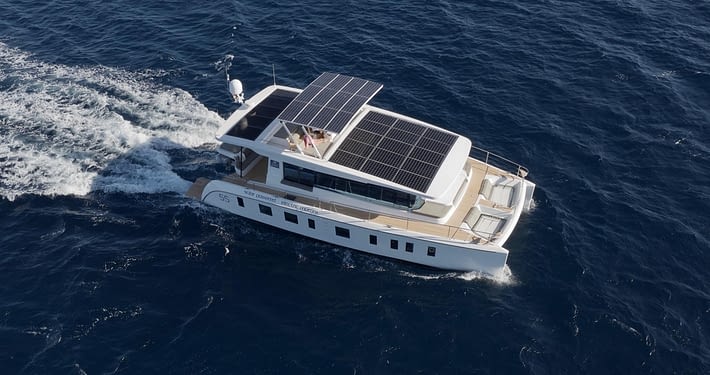
SILENT 55 – The award-winning solar yacht
In November 2019 the SILENT 55 won the “Best of Boats Award” in the “Best for Travel” category.
This special category is defined as “suitable for long-distance travel with all the amenities to live permanently on board, adapted to both inland waters and the harsh conditions at sea”.
In general, it can be handled easily by two people, which makes the SILENT 55 ideal for families who travel with or without additional crew.
General information
Trans-Ocean
Technical information
Displacement (ec).
500 – 1.000 L
Dirty water
600 – 1.600 L
Solar panels
Ce certification, sunlight yachts, office mallorca.
E-Mail-Adresse*
Ihre Nachricht (optional)
Email address*
Your message (optional)
Correo electrónico*
Tu mensaje (opcional)
Deine Fragen (optional)
Anfrage Bootsschule
Welcher Kurs interessiert dich? SBF Normal SBF Speed SBF Frauen SBF 2 Tage Privat SKS SRC
Gewünschter Kursbeginn ab:
Deine Nachricht (optional)

Sustainability Success
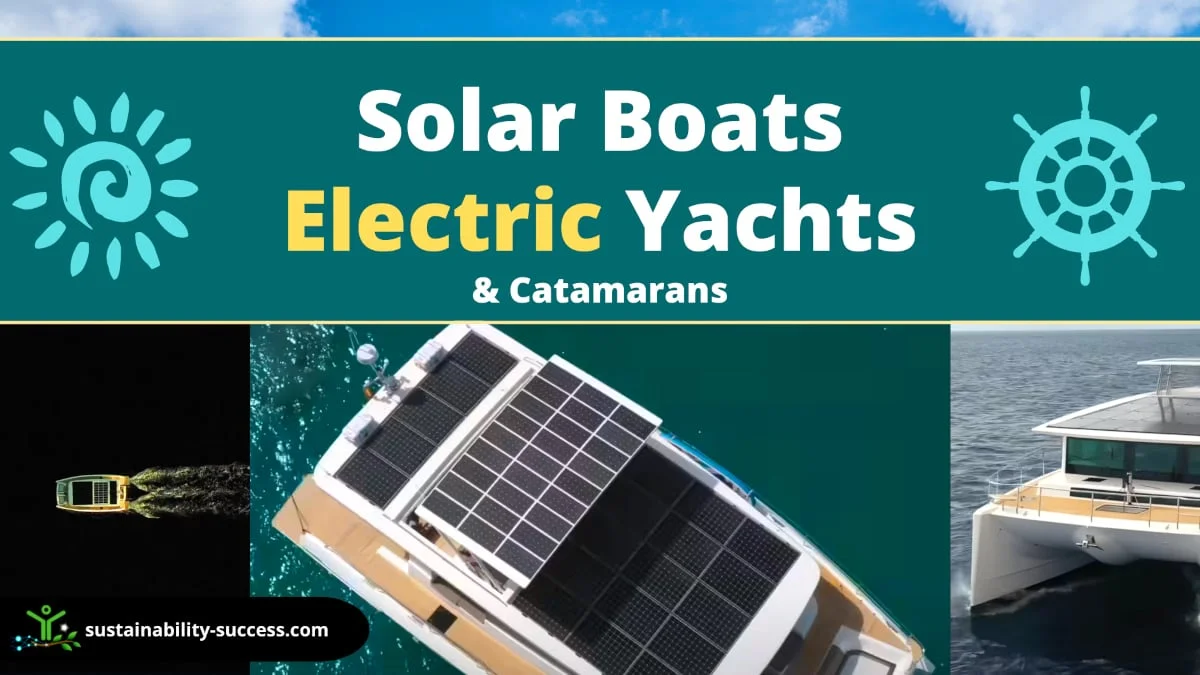
10 SOLAR Boats 2023 & 2024 | Electric Yachts & Catamarans
With more steps being taken towards sustainable development, new, eco-friendly solar boats have been introduced in the world of green travel: solar electric catamarans.
Solar boats are electric yachts that can go for long distances without needing to stop for fuel and without emissions. Those solar catamarans are interesting eco-friendly alternatives to the classic power boat or sailing yacht for cruising. However, there are also a few disadvantages that you should know about before purchasing one!
10 Solar boats, electric yachts & catamarans
Here are the best solar boats that will delight you with a top-notch sustainable yachting experience based on your requirements:
Sunreef Yachts – Eco 80 Sail Catamaran
- Silent Yachts – Silent 80 3-Deck
HH Catamarans – HH44
Silent yachts – silent 60, sunreef 43m eco (140 ft).
- Silent 120 Explorer
- 100 Sunreef Power Eco
Azura Marine – Aquanima 40
Soel yachts – soel senses 48, serenity yachts – serenity 64 (hybrid).
Here’s a quick summary of the features of the best solar catamarans for green yachting in 2023-2024:
| Solar Boats | Solar Powered Electric Propulsion | Sails | Diesel Engine | Size | Price from | |
|---|---|---|---|---|---|---|
| Sunreef Eco 80 Sail | ✅ | ✅ | ❌ | L | $8 mm | ✅ |
| Silent Yachts Silent 80 | ✅ | Kite Sail | ❌ | L | $6 mm | ✅ |
| HH Catamarans HH44 | ✅ | ✅ | ✅ | S | $1 mm | ✅ |
| Silent Yachts Silent 60 | ✅ | Kite Sail | ❌ | M | $2.7 mm | ✅ |
| Sunreef 43M Eco (140 ft) | ✅ | ✅ | ❌ | XL | On request. Expected $23 mm | ✅ |
| Silent Yachts Silent 120 Explorer | ✅ | Kite Sail | ❌ | XL | On request. Expected $19 mm | ✅ |
| 100 Sunreef Power Eco | ✅ | ❌ | Optional Hybrid | XL | On request. Expected $15 mm | ✅ |
| Azura M. Aquanima 40 | ✅ | ❌ | ❌ | XS | $0.6 mm | ✅ |
| Soel Senses 48 | ✅ | ❌ | ❌ | S | On request. Expected $1 mm | ✅ |
| Serenity Yachts Serenity 60 | ✅ | ❌ | ✅ | M | $2.7 mm | ✅ |
If you are an advocate of sustainable yachting or sustainable tourism and are looking to buy an eco-friendly boat that doesn’t rely on fossil fuels , then you would do well to consider getting a solar catamaran. In this article, I will go through the pros and cons of 10 of the best solar yachts and superyachts that you can buy in 2023 and 2024!
It is also important to note that while there are solar panels for sailboats that you can fit on older models, those new boats have been specifically designed to maximize the use of renewable energy.
Most Luxurious + Most innovative solar system
The Eco 80 Sail Catamaran is one of the electric solar boats provided by Sunreef Yachts.
It features a unique “solar skin” that covers all composite structures on the boat, including hull sides, boom, mast, bimini, and superstructure. This green tech makes it possible to place solar panels where it wouldn’t normally be possible (like the hull and any other smaller but useful surface) and provide enough solar energy from every angle.
The boat is 80-feet long (24.38 meters) and includes electric motors that push it smoothly over the water without causing any vibrations or noise.
Besides being solar powered boat, the Eco 80 Sail Catamaran can also be powered by wind and hydropower. It is designed with a sail on its structure, allowing it to tap into wind power and supplement the solar.
The solar powered sailboat generates enough green power not only to propel the boat and keep it moving but also to charge the essential electric water appliances and other water-sport toys.
So far, the Sunreef Yachts Eco solar sailboats have earned a good reputation for being eco-friendly and sustainable. Besides, this solar powered catamaran takes its commitment to the environment a notch higher by using recycled materials , natural fibers, and non-toxic paints to create their boats.
It is no wonder that Sunreef Yachts have been winning environmental awards for so many years. This solar sailboat is one of the most remarkable boats you can ever invest in and it clearly shows the latest advancements in technology .
Prices: about $8 million USD
Where to buy : Sunreef Yachts .
- Larger surface covered with solar panels, that are installed also along the hull, and in other unusual areas.
- The batteries are 30% lighter than normal
- Unlimited cruising range.
- It runs silently and does not cause pollution.
- It has also traditional sails, so it can cruise also when it is not sunny without relying on batteries.
- Luxury, superb quality and finishing
- Great helm position.
- The solar catamaran is very costly (going for $8 million USD or more).
- The solar panels installed on the sides of the catamaran may not be appealing to the eye of all people.
Silent Yachts – Silent 80 Tri-Deck Solar Catamaran
Best pure electric
The Silent 80 Tri-Deck Solar yacht is popular for the large amount of space it offers.
This solar catamaran by Silent Yachts features three large decks that can be easily customized to fit the owner’s preferences and needs. The topmost deck can either be open or enclosed.
This solar powered yacht offers 4 to 6 cabins that are customizable, regardless of whether the deck remains open or enclosed. Besides, the top deck provides additional living space and can be used as a luxury master suite that opens onto a private space outdoors.
Where to buy : Silent Yachts .
- Purely electric propulsion that can be helped by the kite sail.
- The finishing, while being of high standards, doesn’t seem to be at the level of other options in its category.
- Quite costly, with prices starting at about $6 million USD.
- If going for a long cruise during cloudy days you may need to run the generator to keep going.
- The kite sail helps to give some propulsion using wind, but it is less effective than traditional sails.
- The absence of a traditional sail may make the boat a bit less stable, compromising a bit of the comfort while cruising.
Best for world cruising
HH Catamarans is a small boutique boat builder designing some of the most impressive solar boats for cruising, with one of their latest creations being the HH44.
The HH44 is a groundbreaking new boat that is designed to be eco-friendly and efficient.
The boat has a large battery bank that can be charged by solar panels, and also has two electric motors that can be used for electric propulsion up to 7 knots for up to 2h.
The HH44 has an innovative propulsion system named Eco-Drive. This is a parallel hybrid system that combines diesel and electric propulsion for long-range motoring and silent electric propulsion.
The boat also has two diesel engines, which can be used for long-range motoring or to generate electricity. The boat is also designed to be safe, with four propulsion devices plus sails and a large solar array.
The HH44 has a number of technical features that make it a groundbreaking eco-friendly design, including:
- 3 types of propulsion: full electric, standard diesel, and sail.
- 4.2 kWh of solar panels: generating power for recharging the lithium battery bank for solar .
- 10 kW electric motors (5kW each): mounted on the back end of each diesel engine for electric propulsion.
- The diesel engines can be used both for propulsion and as electric generators.
- Possibility to use the propellers to recharge the battery while the boat is sailing. Kind of like using hydropower to charge your solar batteries , pretty cool!
The HH44 is also a performance catamaran thanks to its C-shaped §daggerboards. Daggerboards are an essential component of many sailing vessels, providing both vertical lift and increased upwind sailing performance.
This solar powered yacht features up to 4 double cabins and 2 heads . Not bad for this world-cruising vessel!
If instead, you are looking for a larger boat, HH Catamarans also have other models up to 88ft.
This solar catamaran was also the preferred choice of Gone with the Wynns , a popular cruising YouTube channel. Here’s their announcement video:
Where to buy : HH Catamarans .
- A true performance world cruiser.
- Very resilient with 3 different propulsion modes (electric, sail, and conventional engines) and ideal for offshore cruising.
- It can run silently and without causing pollution.
- More affordable than other solar catamarans, starting from $1 mm USD
- Smaller than other options.
- The improved sailing performance requires narrower hulls, which reduces the available space onboard compared to other traditional vessels of similar size
Best mid-range
The Silent 60 is one of the smaller electric boats made by Silent Yachts. It is designed to be handled by at least two people. The users can either choose to include an additional crew or not.
Despite its outward small appearance, Silent 60 is very spacious and can accommodate a good number of people.
Besides, the electric yacht has a beautiful design that adds to its elegant and luxurious feel. It is usually designed with up to 6 cabins , with each cabin offering every basic amenity you need to have a luxurious stay on the yacht. In fact, the electric solar boat is equipped with everything you need to allow you to live on board permanently!

As someone who loves spending time on the water, I was really excited to learn about the Sunreef 43M Eco: a superyacht that is both eco-friendly and luxurious.
I was especially impressed by the solar power system, which is built into the composite structures of the yacht, and the large hydraulic platform which creates a vast walkaround beach club.
The interior of the solar superyacht is just as impressive as the exterior, with a variety of sustainably-sourced materials and fabrics used throughout as well as energy-saving air-conditioning. The Sunreef 43M Eco can welcome up to 12 guests in the most luxurious conditions.
Silent Yachts – Silent 120 Explorer

Here’s another incredible solar super-yacht by Silent Yachts. The Silent 120 Explorer is a truly unique yacht, designed to explore the world in style and comfort.
Powered by solar energy, this solar catamaran is perfect for those who want to enjoy the beauty of the open seas without worrying about the impact on the environment.
With plenty of space for guests and all the amenities you need onboard, the Silent 120 Explorer is the perfect choice for your next adventure. If you’re looking for a yacht that combines luxury and environmental responsibility, the Silent 120 Explorer is a perfect choice.
The company didn’t yet release detailed information, however, this superyacht seems to be even featuring a helipad under the roof’s solar panels!
The Silent 120 Explorer has plenty of room for guests and all the amenities you need onboard. So if you’re ready to embark on your next great adventure, be sure to consider the Silent 120 Explorer, which will likely start being delivered in 2023.
The 100 Sunreef Power Eco
Sunreef recently launched and sold their first 100 Sunreef Power Eco catamaran, a transatlantic luxury craft that takes solar boat design to the next level.
With massive living space, great autonomy, and impressive features like a flybridge that can be transformed into an outdoor cinema, the 100 Sunreef Power Eco is the perfect vessel for cruising in supreme luxury
This catamaran uses the latest innovations in solar power to achieve outstanding energy efficiency, and its ultralight battery bank provides for silent cruising and infinite range.
The fully customizable interior and exterior make this catamaran a truly one-of-a-kind option, and its use of ethically-sourced and eco-responsible materials is sure to please even the most discerning buyer.
If you’re looking for an electric yacht that is both luxurious and eco-friendly, the 100 Sunreef Power Eco is certainly a great option for you if you can afford it!
The most affordable $
The Aquanima 40 catamaran is entirely powered by solar energy. It features creative adaptations and unique innovations that make it eco-friendlier and more economical boat than other solar-powered catamarans. For example, the solar panels installed on the electric catamaran are built in such a way that they can sell any excess solar energy back to shore stations when connected.
The exterior of the Aquanima 40 has an elegant design. Also, the interior is not only aesthetically pleasing, but also very clean and modern.
The boat is designed with 2 single cabins for the crew and 2 double cabins for guests.
Indeed, this solar boat by Azura Marine is one of the most economical and cost-effective options you can go for when buying a solar catamaran.
- Relatively fast.
- Ideal for short vacations.
- The most affordable solar catamaran, starting at about $0.6 million USD.
- Much smaller than other options.
- Not recommended for long cruises.
- Basic looks and layout.
As its name suggests, the Soel Senses 48 is 48 feet long. It has a slender design and is lightweight , making it more economical than most other solar-powered boats.
The boat is designed with two sleeping berths that can accommodate two people each. It also includes a salon that can offer enough sleeping space for four people.
Compared with most other solar yachts, the Soel Senses 48 has a much smaller size. Its size, adding to its sleek and innovative design, give it faster speed than other solar-powered boats.
It incorporates 12 solar panels installed on the roof ; all these panels generate a combined electrical power of up to 2.7 kWh. The electricity generated by the solar panels is then stored in two batteries which can be easily configured to hold a maximum solar power of 142 kWh.
Like other Soel Yachts, the Soel Senses 48 glides smoothly over water without causing any noise, rattles, or generating fumes.
It has average cruising speeds of 10 knots, even reaching top speeds of up to 18 knots. However, the solar catamaran cannot run at its top speed for long periods.
Both the interior and the exterior of the Soel Senses 48 have a sleek and modern design. Every single component of the solar catamaran has been designed carefully to make it as functional and comfortable as possible. Therefore, when you board on this boat, you can expect to experience one of the best sailing experiences of your life.
The Serenity 64 Yacht features a diesel engine. It is a hybrid solar boat, which means that it can run on either solar power or on diesel.
The diesel engine especially comes in handy when the users wish to achieve faster cruising.
The solar catamaran is a very spacious electric boat and provides plenty of living space. It is built with four luxurious cabins, with each cabin having its ensuite bathroom. And even though the Serenity 64 is smaller than the Serenity 74 model also built by Serenity, it still provided an elegant feel and a smooth sailing experience.
Solar Boats Pros and Cons
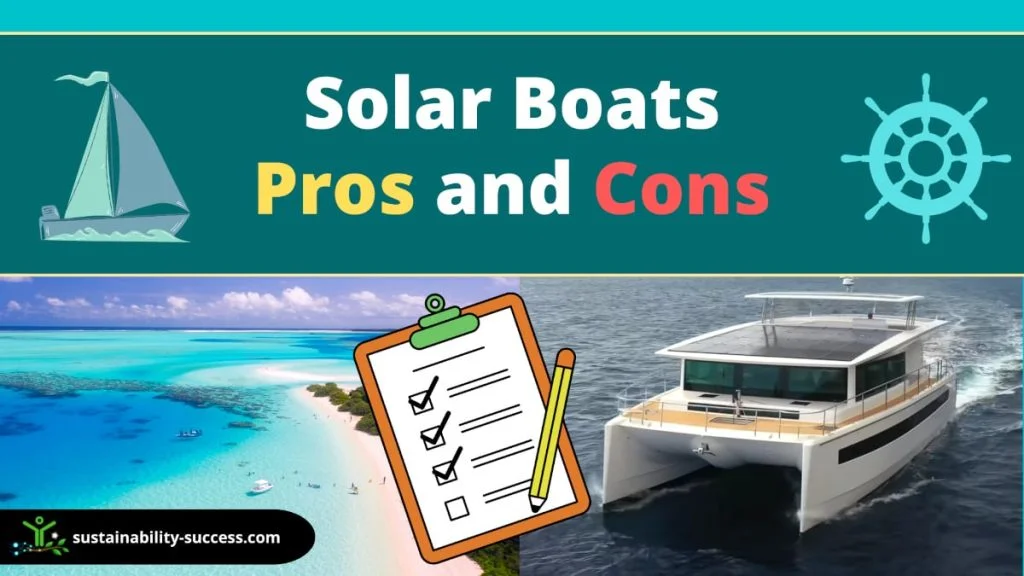
The sun is a powerful and free source of energy, making solar power an attractive option for those looking to power their yacht. Solar panels can be used to generate electricity to run the yacht’s lights, appliances, and even the engine. Solar power can also be used to heat water for showers and laundry. But, what are the pros and cons of solar catamarans?
Here’s a quick summary of the solar yachts’ advantages and disadvantages:
| Advantages of solar boats ✅ | Disadvantages of solar boats ❌ |
|---|---|
| Eco-friendly: solar power is clean and renewable | More expensive than standard boats |
| They (mostly) don’t require fuel | Solar panels work well only during sunny days |
| Reliable | You will still need a (diesel) generator onboard: for both safety and continuity of power |
| Reduced maintenance costs | Reduced stability while cruising (If without sails) |
| Cost-effective in the long run | The smaller versions of solar yachts will have quite limited cruising speed when using only the power from solar |
| Potentially unlimited range, especially for the larger solar catamarans | |
| Possibility to sell back the excess power to shore (when connected) | |
| No restrictions on electrical use |
One of the main benefits of solar power is that it is renewable and environmentally friendly. Solar panels have no emissions and do not produce pollution. In principle, they also do not require fuel, making them very cost-effective in the long run. Solar power is also very reliable, as the sun is a constant source of energy.
There are a few disadvantages to solar power. Solar panels can be expensive to install, and while they require less maintenance, this can be quite costly, especially when it will come time to replace the batteries. Solar panels also need to be pointing directly at the sun to be effective, so they may not generate power on cloudy days or at night.
But there’s more, let’s see what some sailing experts are thinking about solar catamarans!
Sailing expert’s solar Boat review
Recently, one of the most popular sailing YouTube channels, Saliling La Vagabonde , published a very honest and interesting review of the solar powered yacht Silent 55. Here’s a summary of their experience:
- 7 Days onboard (6 nights)
- Travelled 145nm with an average speed of 7 knots
- Generator used for about 12h (in total)
- Fuel consumed: 208 liters
Here are some interesting observations they made:
- While cruising it may feel less stable than a standard sailing boat because it doesn’t have a sail to stabilize it when hitting the waves.
- For the Silent 55 it was possible to move at about 3 knots by using only the power generated by the solar panels (without using the batteries) on a sunny day. This means that if you are moving the solar yacht around quite frequently, you will end up using the generator quite a lot to produce the necessary power.
- When the batteries are out of power, the Silent yacht is using a (diesel) generator to supply the necessary power to keep the boat moving and to power the appliances.
- A great luxury yacht with all the comforts and going in the right direction for the future of the sector.
- Overall, the Silent Yacht is a great eco-friendly alternative to a power boat , while if you are thinking about cruising around the world, you would be probably better off going for a standard sailboat (or for some of the hybrid alternatives mentioned in this article, like the HH44).
Why are solar yachts all catamarans?
Solar yachts are all catamarans for 2 main reasons:
- Catamarans have a larger surface, which allows for placing more solar panels and also offers more room for the batteries onboard.
- Catamarans have efficient hulls for their size. This reduces their power consumption while moving.
This makes catamarans the ideal platform to build a solar-powered boat.
Modern solar electric boats are undoubtedly an eco-friendly choice in sea travel and a form of green tourism . Not only do these electric boats provide a smooth sailing experience, but they also reduce the release of emissions into the atmosphere, reducing the environmental impact and enhancing sustainability .
Luckily, given their size, solar catamarans can charge themselves (unlike electric cars ), so they can sail indefinitely without the need to stop for refueling.
If you are environmentally conscious and looking to get a boat that is more viable, desirable, and eco-friendly, you may consider investing in one of the solar yachts discussed in this article!

- solar electric yachts
- Soel Senses 62
- Soel Senses 82
- Soel Shuttle 14
- Custom model
True ecotourism
no more fuel
The SoelCat 12 is an energy autonomous solar electric boat, designed from the ground up as a fully sustainable excursion vessel to enjoy the sea. The solar catamaran brings true eco-tourism to water-bound operators, communities, resorts, lagoons and nature reserves. With no CO2 or noise emissions involved, we can save the ocean and offer a better experience to our guests! The heart of the concept is silence : being on board without any distractions lets the journey become the destination!

“Being on the solar catamaran gives you a feeling of total relaxation and freedom. The energy autonomous boat is powered by clean energies and we don’t have to worry about harming the environment with dirty exhaust fumes, fossil fuels or complicated maintenance! Our guests love the quietness and the openness of the vessel, which make every sunset cruise a very special moment!”
S. Dekeunynck, French Polynesia
electric from the start
The SoelCat 12 solar electric catamaran is integrally designed for electric propulsion right from the first line drawing to the matched propeller. Every aspect of this vessel contributes towards its highly efficiency for solar electric sailing. The lightweight yet durable fibreglass construction, the large solar roof and the super slender hulls are the major key factors for the solar vessel’s high performance when it comes to speed and range. The electric propulsion system for the SoelCat 12 is superior when it comest to volume and weight.
MOBILE POWER STATION
During downtime, the SoelCat 12 can utilise its large solar array to provide energy for your land based electricity grid. The solar electric catamaran then turns into a mobile power station and is able to feed 8.6kWp into the AC grid or provide power at remote places where no grid is available. The 120kWh lithium battery system supplies all the energy required for save operations during day and night.
SPECIFICATIONS
| Length | 11.80 m | 39 ft | |
| Beam | 5.80 m | 19 ft | |
| Draught | 0.70 m | 2.3 ft | |
| Displacement | 6 ton | 13.200 lb | |
| Solar Power | 8.6 kWp | ||
| Battery Capacity | 2x 60 kWh | ||
| Electric Motor | 2x 30 kW | ||
| V | 13 kn | ||
| V | 8 kn | ||
| V | 6 kn | ||
| Passengers | 12 – 20 | ||
| Crew | 4 | ||
| CE Design Category | C |
- Running Time (battery only)
- Running Time (with solar)

“Every detail on the boat is perfect – gorgeous spaces to relax, great spots to view the sunset or the marine life, and even a bar! My favorite moment of all was after sunset, when an incredible manta ray came to say hello, drawn by the underwater lights of the solar catamaran.”
S. Lee, New Zealand
fully customizable
The deck space of the solar electric boat can be customised to your wishes and host a variety of seating arrangements and layouts. Choose classic yacht fittings, luxurious and comfortable. Or practical and economical deck wear and simple bench setup for water taxi services. Furthermore, the electric catamaran can be equipped with a day head in the port side hull. Get in contact with us now to learn more about the different options and to discuss your personal requirements with your Soel Yachts contact partner.

The solar electric catamaran can be equipped with removable roll down screens on every side for flexibility in every situation. Screens for sun shading can be applied on good days, while transparent rain screens protect your guests in bad weather conditions. When the screens are not in use, the comfortable SoelCat 12 lounge layout offers spacious space options in the hulls and underneath the furniture.

SUSTAINABLE SEA TRANSPORT
With both the Okeanos Foundation and Soel Yachts sharing a vision of sustainable sea transport and striving for a healthier planet, we are honoured that our partner, the Okeanos Foundation has funded and supported the development of the SoelCat 12. The first SoelCat 12, named the ‘Okeanos Pearl’ is the first energy autonomous vessel for the ecotourism industry and will pave the way for more sustainable coastal water vessels in many different sectors. The Bora Bora Pearl Beach Resort is proving a pioneering spirit by operating the solar electric Okeanos Pearl. As the first resort, they are offering truly sustainable, noise and emission-free excursions in the pristine lagoon of Bora Bora to their guests.
Demountable
The SoelCat 12 can be delivered as a demountable solar electric boat, which fits into two 40ft high cube containers. Such compact dimensions enable ease transport of the catamaran at affordable rates to destinations all over the world. Neither lamination processes or specialized tools are required for the SoelCat 12’s quick assembly on location. For more details, please feel free to follow the link below and discuss your project requirements with your Soel Yachts partner!
Your project enquiry

- Search Used Yachts For Sale
- Search Boats By Brand
- Search Boats By Type
- Search By Location
- Search By Price
- What's My Boat Worth?
- Search Boats Just Listed
- Small Yachts
- Custom Sport Fishing Boats
- Finance A Boat
- Amer Yachts
- Aquitalia Yachts
- Cabo Yachts
- Century Boats
- French Yachts
- Gulfstream Yachts
- Hatteras Yachts
- Shelter Island Yachts
- Solaris Yachts
- Sunpower Yachts
- Sunreef Yachts
- Vela Boatworks
- Virtus Yachts
- Why List With United?
- Why Own A Boat Or Yacht?
- Custom Website For Your Yacht
- United Sold Boats
- Buy A Yacht With Crypto
- Find a Yacht Broker Near Me
- Search For Broker By Name
- Meet The United Support Team
- Our History
- Fort Lauderdale Boat Show
- Stuart Boat Show
- Miami Boat Show
- Palm Beach Boat Show
- Other Boat Shows
- Yachting News
- Yacht Closing Services
- River Forest Yachting Centers

Search All Yachts
New Silent Yachts For Sale
Silent yachts are the industry leader in ocean-going production yachts that are completely solar sustainable and powered by solar energy. seaworthy, luxurious, and built to impeccable standards, silent yachts are already desirable without its solar capabilities. with the abundance of solar panels on board each boat, every silent yachts model is able to cruise for 100 nautical miles in complete silence. even while at anchor, the solar-powered generators keep the yacht powered quietly for an unprecedented boating experience. enjoy all the benefits of a power catamaran with the addition of solar energy..
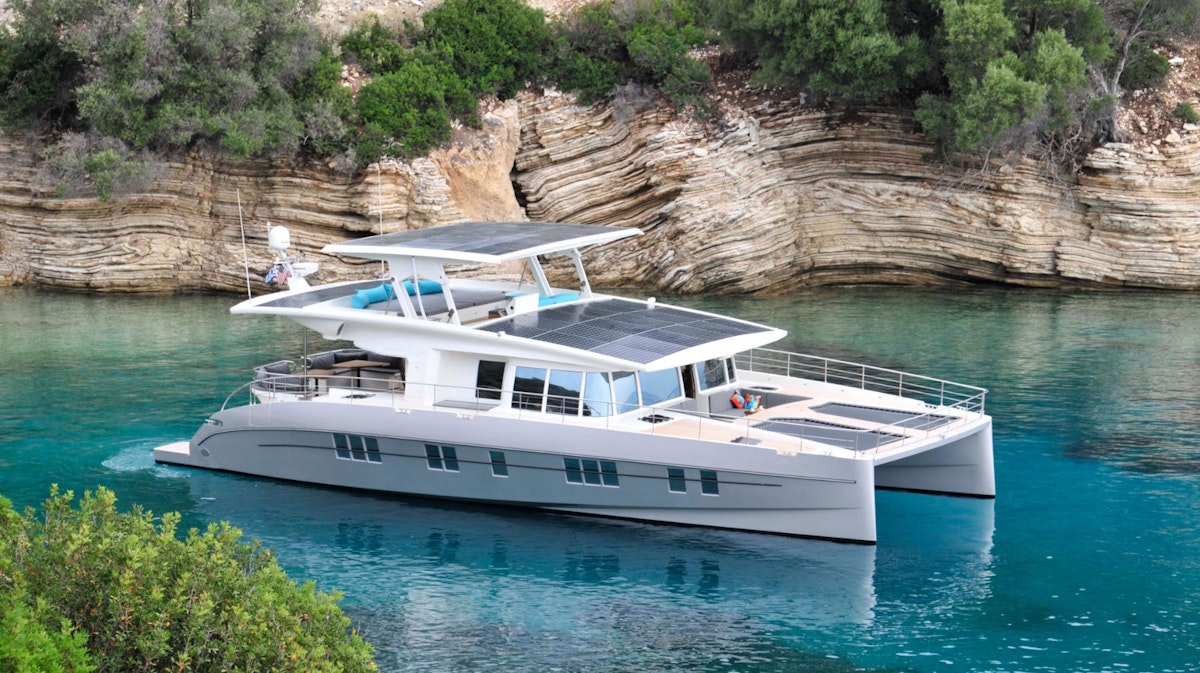
Silent Yachts
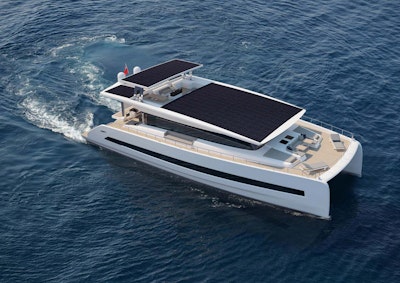
Silent Yachts 80
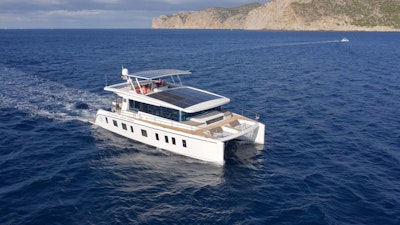
Silent Yachts 55
Speak To A Silent Yachts Sales Professional
Silent Yachts offer an environmentally conscious choice when it comes to owning a yacht. Silent Yachts currently offers three solar-powered power catamaran models including the Silent 55, Silent 64, and Silent 80. United Yacht Sales is proud to be the U.S. distributor for Silent Yachts and can assist you in your search for the world's first solar-powered yacht. For more information, please contact United Yacht broker Darren Sell at (561) 351-7333 or by email at [email protected] .
Where are Silent Yachts built?
Silent Yachts are built through two different shipyards depending on the model. The Silent 55 is built at the world-class shipyard of Mazarin German Yachts which also has a production site located in China. For over 70 years, Mazarin has been a leader in quality yacht construction with over 400 yachts delivered. Mazarin are experts in innovative construction processes that are able to produce light weight yachts.
The Silent 64 and Silent 80 are produced at the Italian-based shipyard Consorzio Navale which is a prestigous consoritum of builders and sub-contractors in the industry. The group has serviced many of the major Italian yacht brands such as Ferretti Yachts and Riva Yachts . Additionally, the Silent Yachts 80 features styling and design by Marco Casali and naval architecture by Insenaval.
Are Silent Yachts really completely solar-powered?
The short answer is yes. Owners can choose to go 100% solar-powered or install diesel engines should higher speeds want to be achieved over longer distances. Silent Yachts can cruise up to 100 miles per day by power acquired through its solar panels. Every day the solar panels are able to generate more power than the total consumption needed for propulsion at cruising speeds plus powering all of the appliances on board.
How does the solar power work?
The Silent Yachts power system feeds the electric propulsion of the power cat and all of the energy it needs to run the A/C, refrigerators, and other household appliances. Light-weight lithium batteries provide an ample amount of energy for everything on board. The lithium batteries used in Silent Yachts are the most expensive ones on the market, but also the most reliable, safe, and have the longest life span.
Solar panels are integrated to the roof of the flybridge hardtop sections instead of just being bolted on top, resulting in no wind load or resistance againest them. Below is a video explaining how the system functions and operates back when Silent Yachts were originally called "Solar Wave":
Who is the team behind Silent Yachts?
Heike and Michael Kohler have sent almost their entire lives on a boat. After more than two decades of using various boats, cruisers, and sailboats on multiple oceans, they became dedicated to finding a better energy source for the propulsion of yachts. Between the years of 2005 and 2009, Heike and Michael tested a number of a multitude of various alternative energy sources. In 2009, SolarWave 46 was launched as a proof of concept for their design. While there are many boats and yachts built that use solar power in some fashion, the Solarwave 46 was the first ocean-going yacht to use solar energy to power everything on board from engines to appliances.
What else is different about how Silent Yachts are built?
Certainly the solar-powered engines and generators are the distinguishing characteristic, but there are a lot of other features that make each Silent Yacht unique. For example, the molds were created using a CNC-milling machine that is able to contruct particular shapes for an optimized design. The materials used in the hull include a carbon compositie that is then resin-infused for a light-weight, but very strong platform. Every hull is fully insulated and the long-term durability is exceptional thanks to the high-quality resin used in the infusion process.
What propulsion systems are recommended by Silent Yachts?
Silent Yachts recommends the 2 x 135 engines as the best solution. If the owner is making frequest trips from Point A to B (Say Miami to the Bahamas for example) the faster hybrid is recommended. The main differentiator here is cruising speed. If the owner is living on the yacht for an extended period of time, rarely pushes the engines to top speeds, and stays below 12 knots, then the E-Power is recommended.
When the generator is running, does the 100Kw go to charging the batteries (which run the 250 Kw e-Motors) or directly to the e-Motors?
All of the enery consumers and producers are connected to the bus bar. If there happens to be more power produced than consumed, the excess power goes to re-charge the batteries. If for some reason more power is required than what is produced, the needed power comes from the lithium batteries.

What is the sustained speed if both 100 Kw generators are running?
This answer really depends upon sea condition and the weight of the boat (for example components, additional equipment, water toys, etc.). The sustained speed on average though is between 12 and 14 knots, 10 knots with one generator running. It is possible to cruise at 10 knots without a generator running when using the Solar E-Power.
Worldwide Yacht Sales
- Million Dollar Yachts For Sale
- 6 Million Dollar Yacht
- Hiring A Luxury Boat Captain
- Boat Sales Charleston SC
- Used Boats For Sale in Alabama
- Bay Boats For Sale in Corpus Christi Texas
- Yacht Search By Location
- Boat Sales Massachusetts
- Used Boats For Sale Stuart Florida
- Yachts For Sale in Georgia
Luxury Boats & Yachts
- Center Consol Boats For Sale
- 2 Million Dollar Boat
- Broward Yachts
- Hinckley Boats For Sale
- Sabre 42 For Sale
- Yachts For Sale by Price
- Yacht For Sale USA
- Ocean Yachts For Sale
- Sailboats For Sale Texas
Popular Builders & Models
- Back Cove Boats For Sale
- Small Tug Boats For Sale
- 40 Sea Ray Sundancer
- Grand Banks Trawler
- Catamaran Boat For Sale
- Sea Ray 58 Sedan Bridge For Sale
- Express Cruiser For Sale
- Fast Boats For Sale
- Sea Ray 460 Sundancer For Sale
- Bavaria Yachts
Trending Brands & Types
- Luhrs Boats
- Bayliss Yachts For Sale
- Nordhaven Yachts
- Jarrett Bay Grander
- Silverton For Sale
- Vanquish VQ32 For Sale
- Used Boston Whaler For Sale
- Regal Boats Prices
- Hcb Yachts For Sale
- Hatteras Motor Yacht
- Carver Yachts For Sale
- Tartan Sailboats For Sale
- Buddy Davis For Sale

Timeless design meets state-of-the-art technology
More spacious, bolder with premium levels of elegance and comfort. The 80 Series combines our state-of-the-art solar electric drivetrain with unmatched refinement. Her timeless exterior and modern interior features bespoke design by none other than renown Italian yacht designer Marco Casali. Highly advanced hydrodynamics make for an incredibly smooth cruising experience. She can be either configured with a flybridge or as a 3-deck version and can easily accomodate additional crew.
Specification
Deck options, silent 8o 3-deck open.
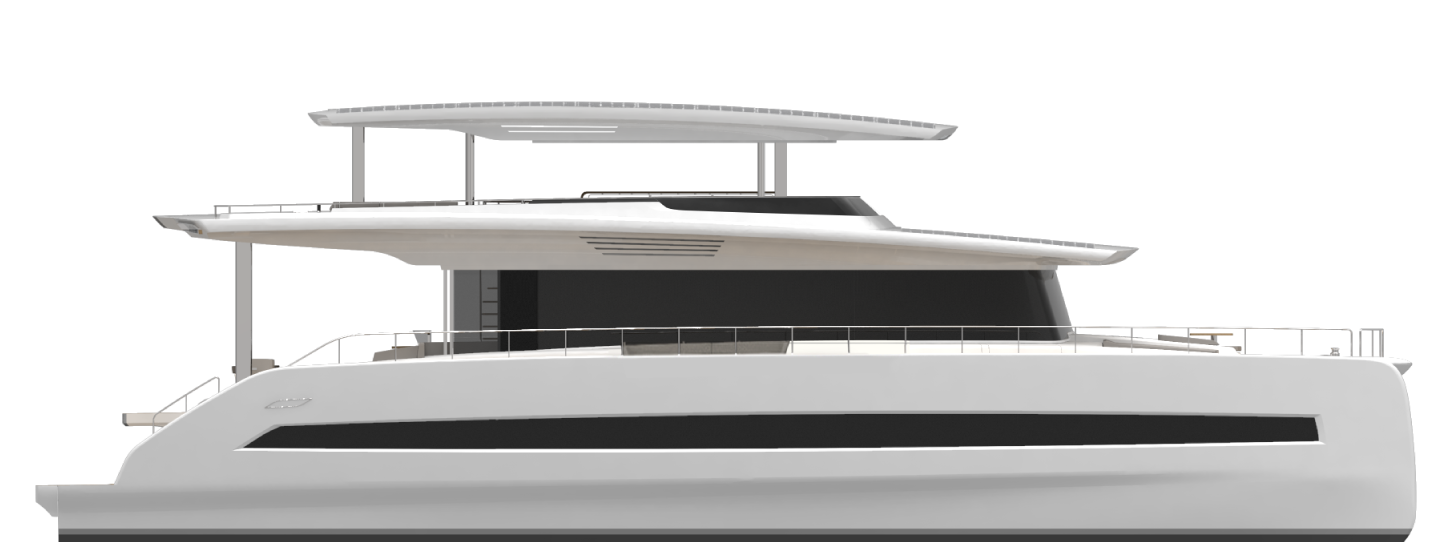
A complete third deck instead of the flybridge provides a total 84 m² of sky lounge space. The open sides create an outdoor ambience which offers a perfect mixture of sun and shade for relaxing owners and guests. Of course, the open third deck can be customized towards the owner´s needs.
Silent 8O 3-Deck Closed
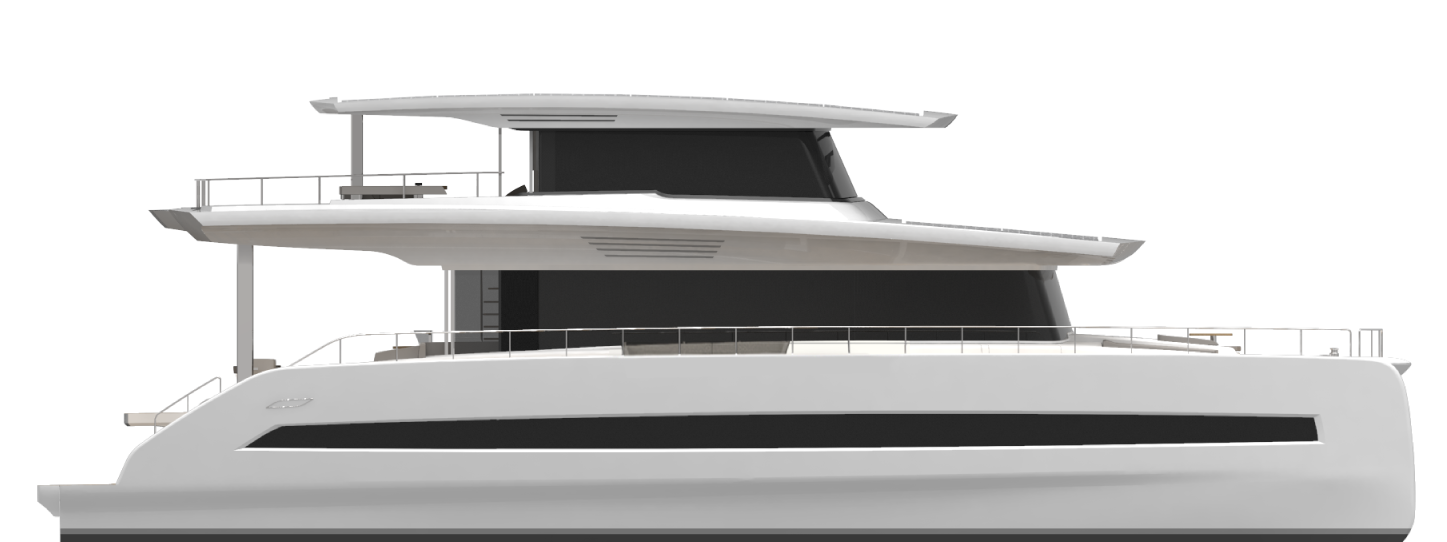
The closed 3-deck version features an owner’s suite with a private 41 m² aft terrace. Those who value sharing their experiences on board can opt for an indoor lounge instead. It is comprised of a 39 m² dining area, fully equipped with a bar and galley, while still maintaining the same terrace in the aft.
Silent 8O Flybridge
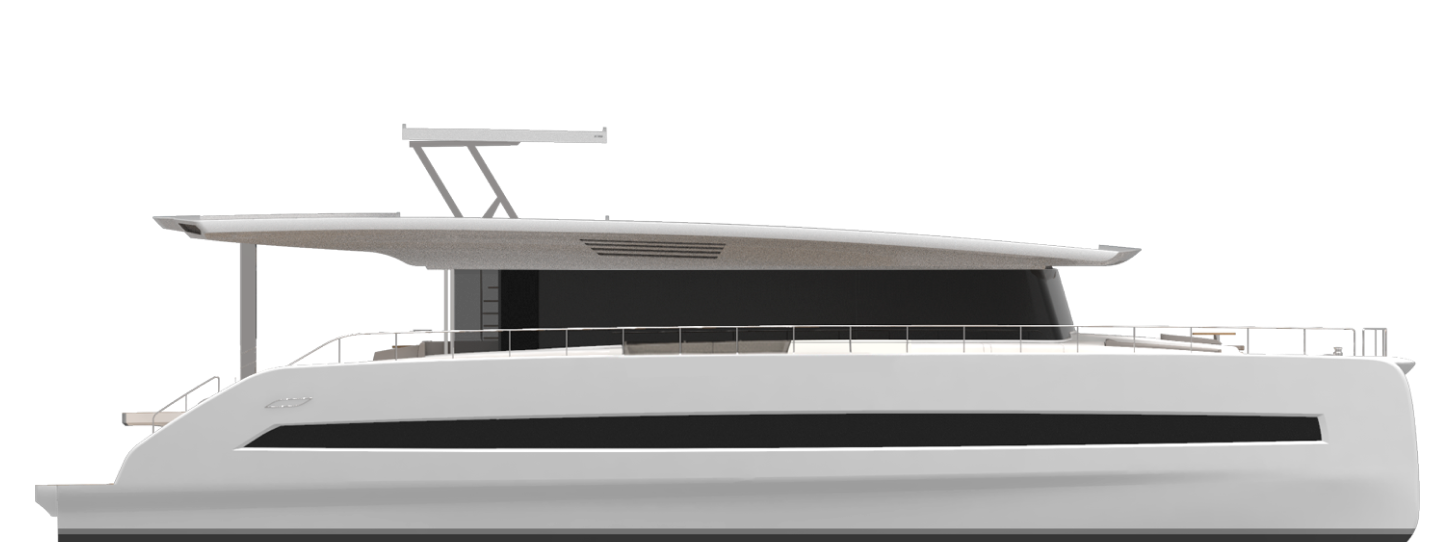
Just as the 60 Series, the 80 Series can also be configured with a retractable flybridge. With 53 m² of space, the flybridge version already offers plenty of room and is equipped with a dedicated helm station to steer the yacht while enjoying the 360° view.
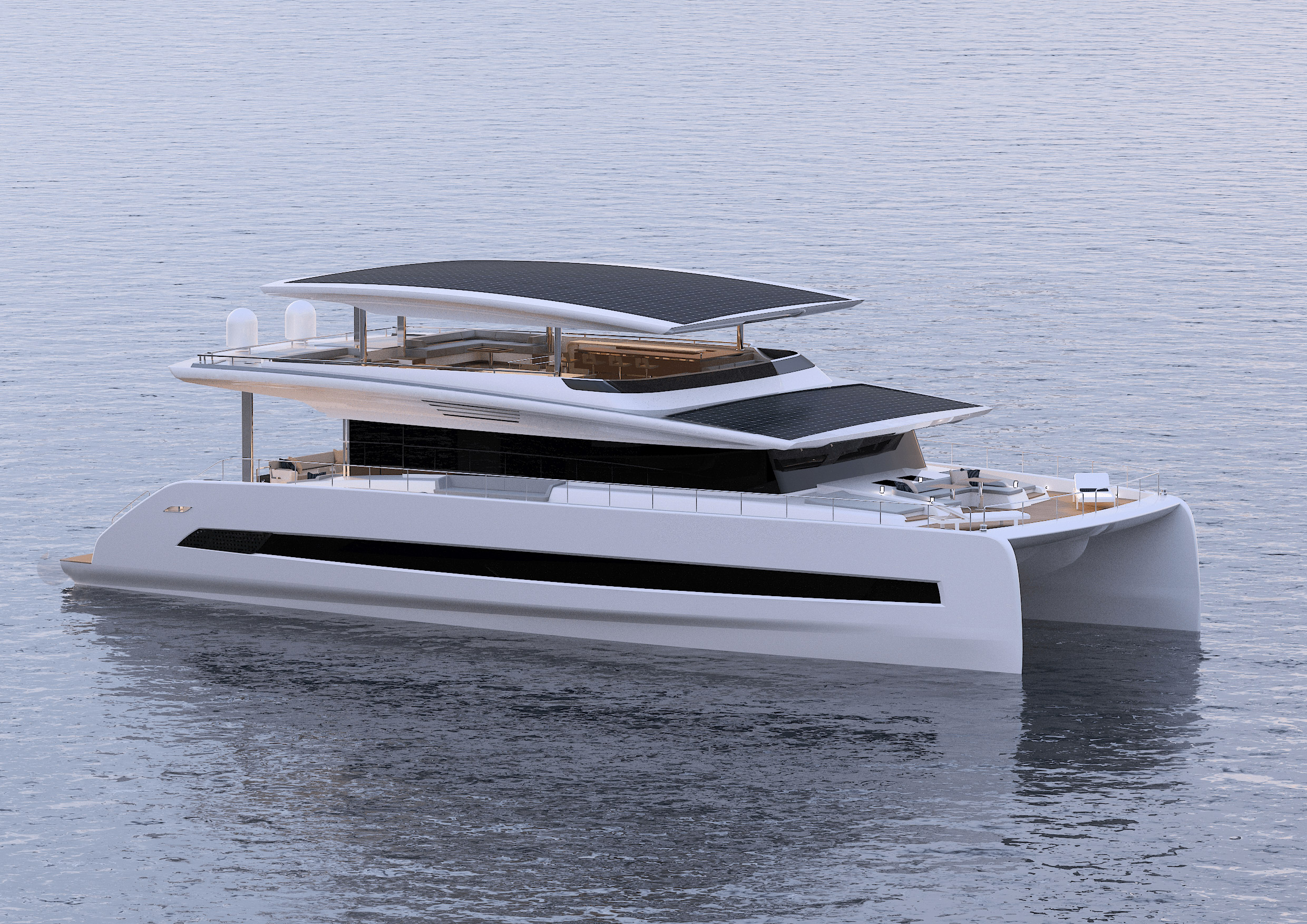
3-Deck Open
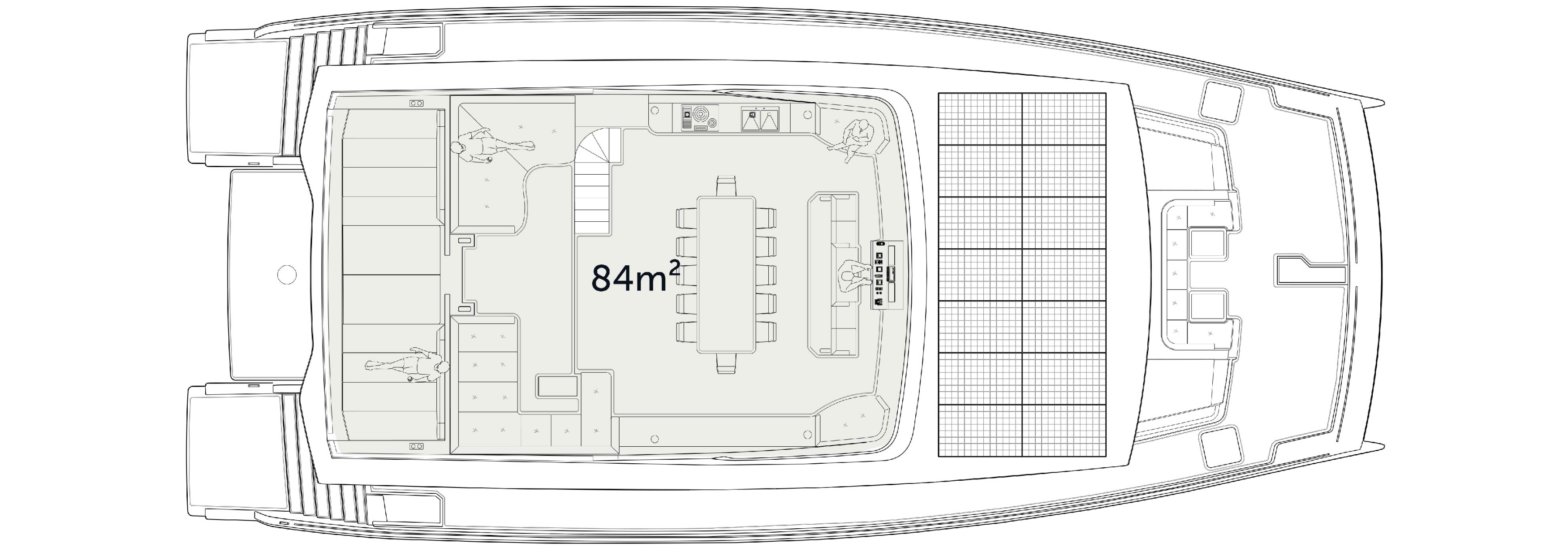
3-Deck Closed
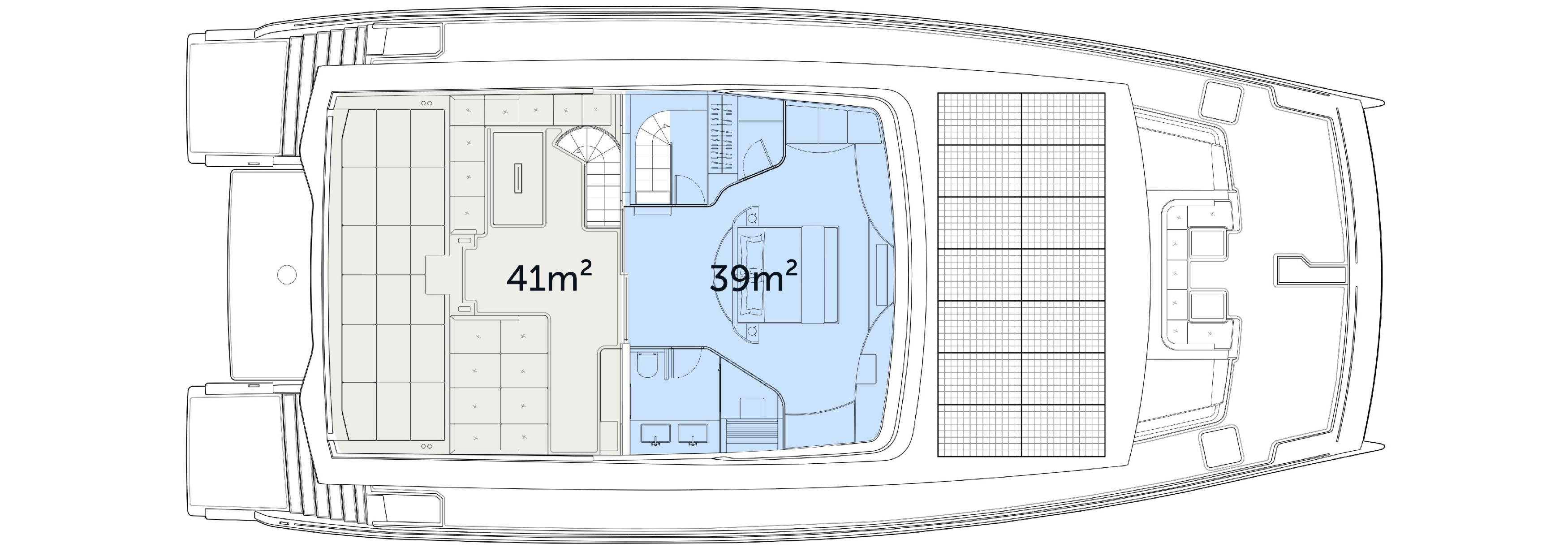
Version 1 (4+2 Cabins)
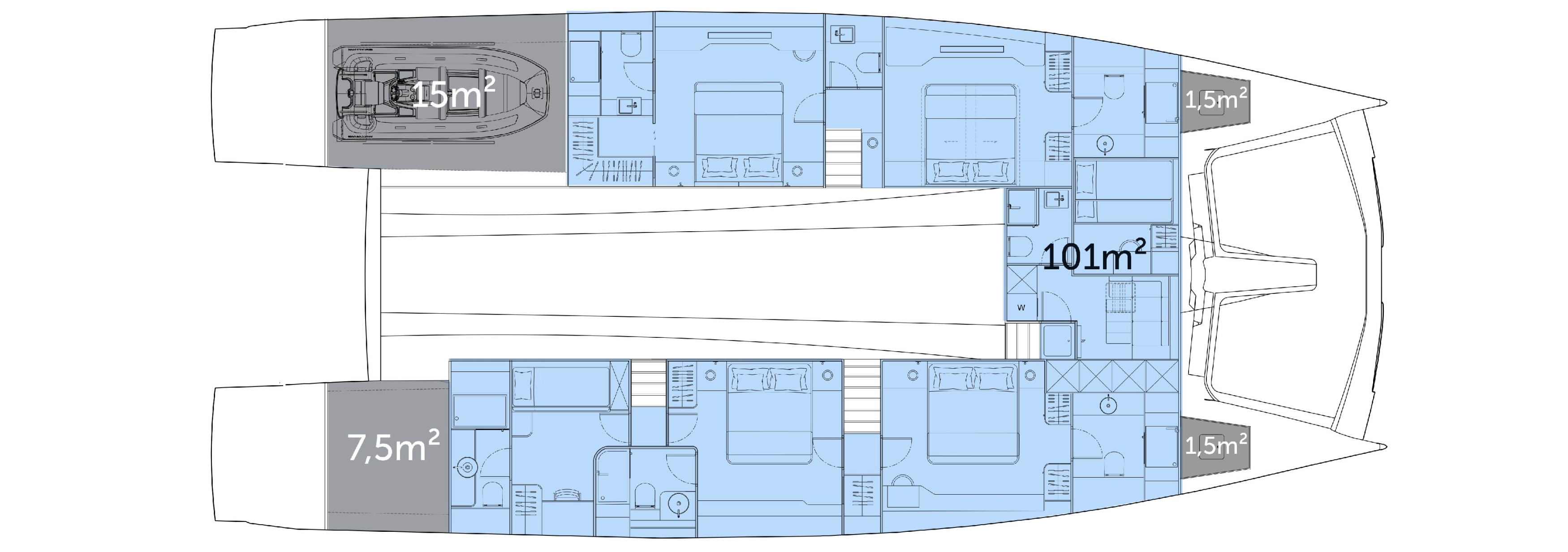
Version 2 (4+2 Cabins)
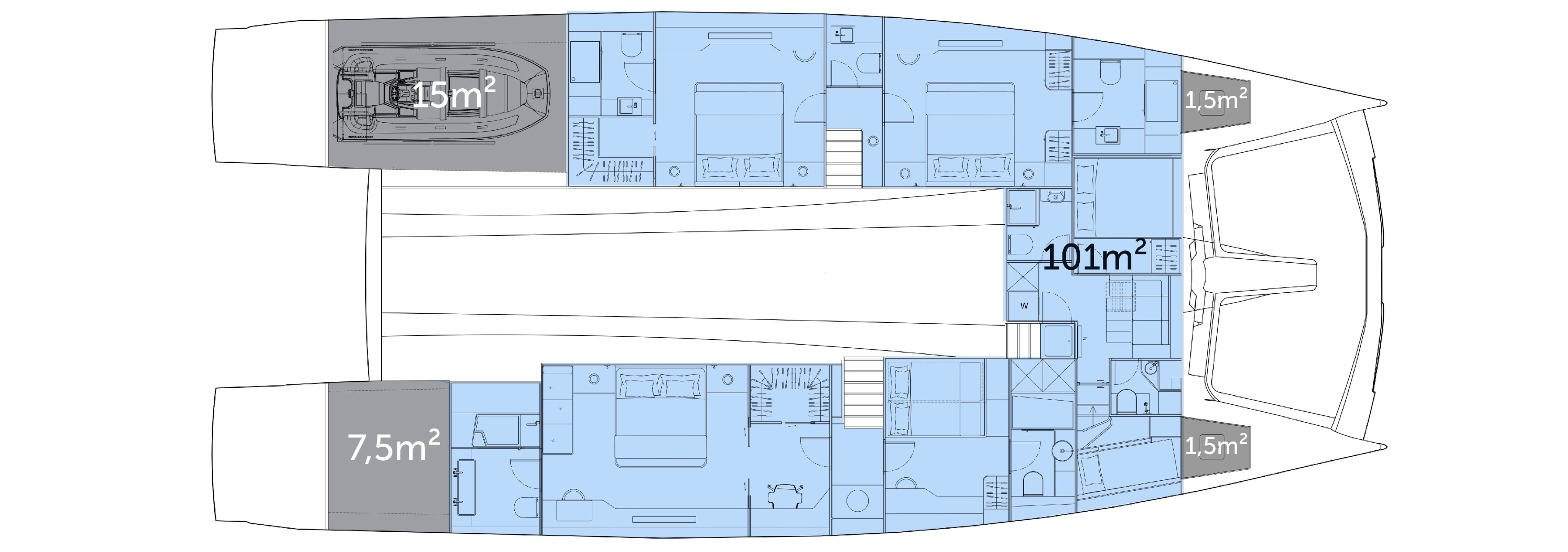
Solar-electric yachting advantages
Unlimited range, noiseless cruising, zero emission, minimal maintenance, powertrains, 8o series highlights.
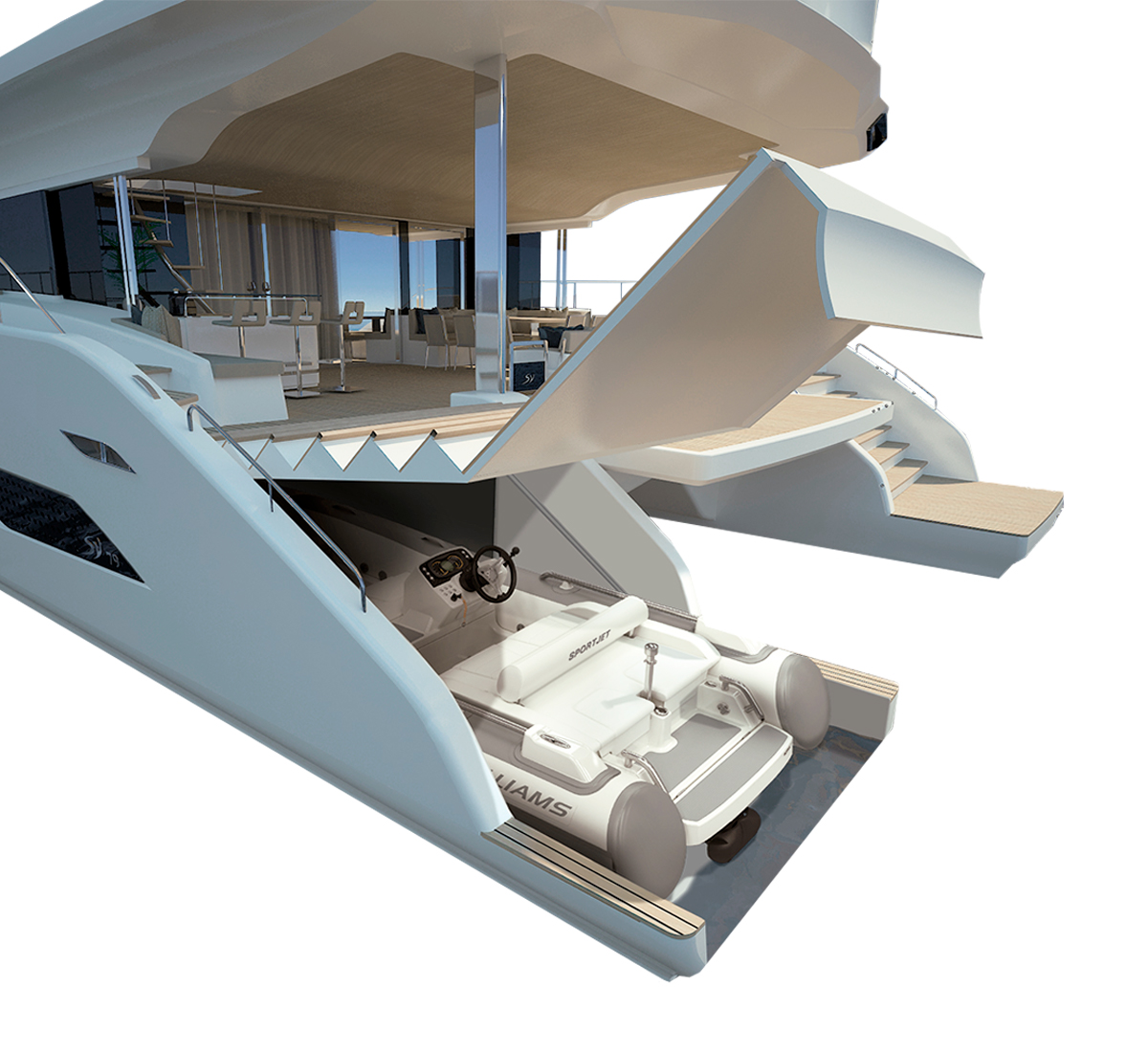
Tender garage
In the aft of the portside hull, the staircase can be raised to reveal a fully enclosed tender garage. It fits tenders with a maximum length of up to 5.20 m, such as the Silent Tender 520, and has a direct charging point to recharge electric tenders with energy produced by the yacht.
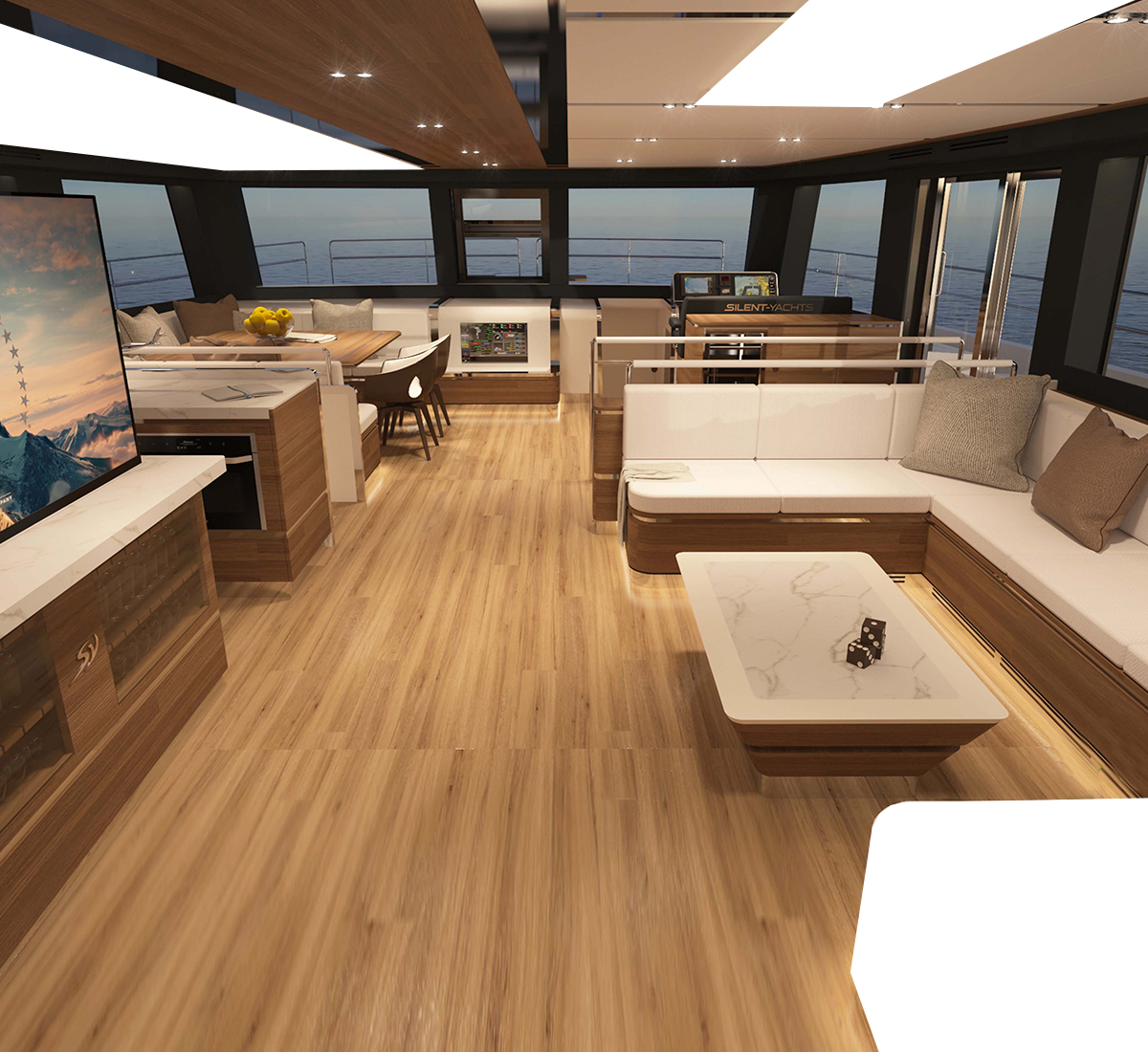
Largest salon area
When compared to other catamarans of similar size, the 52 m² salon of the 80 Series leads with the largest amount of interior space. This creates a lounge like ambiance which offers all the necessities such as a fully equipped galley to enjoy your stay on board.
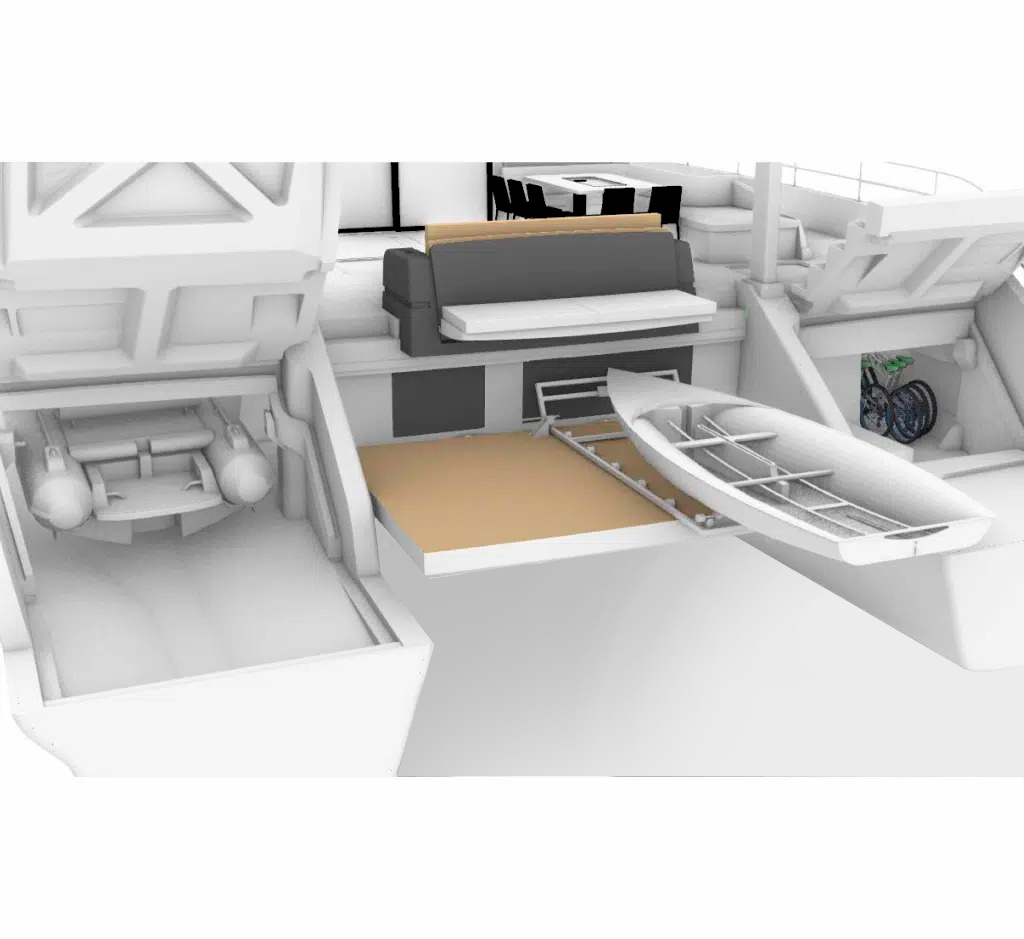
Aft storages
Inside the bridgedeck there is a large storage for water toys. Additionally, in the starboard side there is another storage compartment for diving gear, bicycles and motorbikes which can be accessed through hydraulically liftable stairs from the aft.
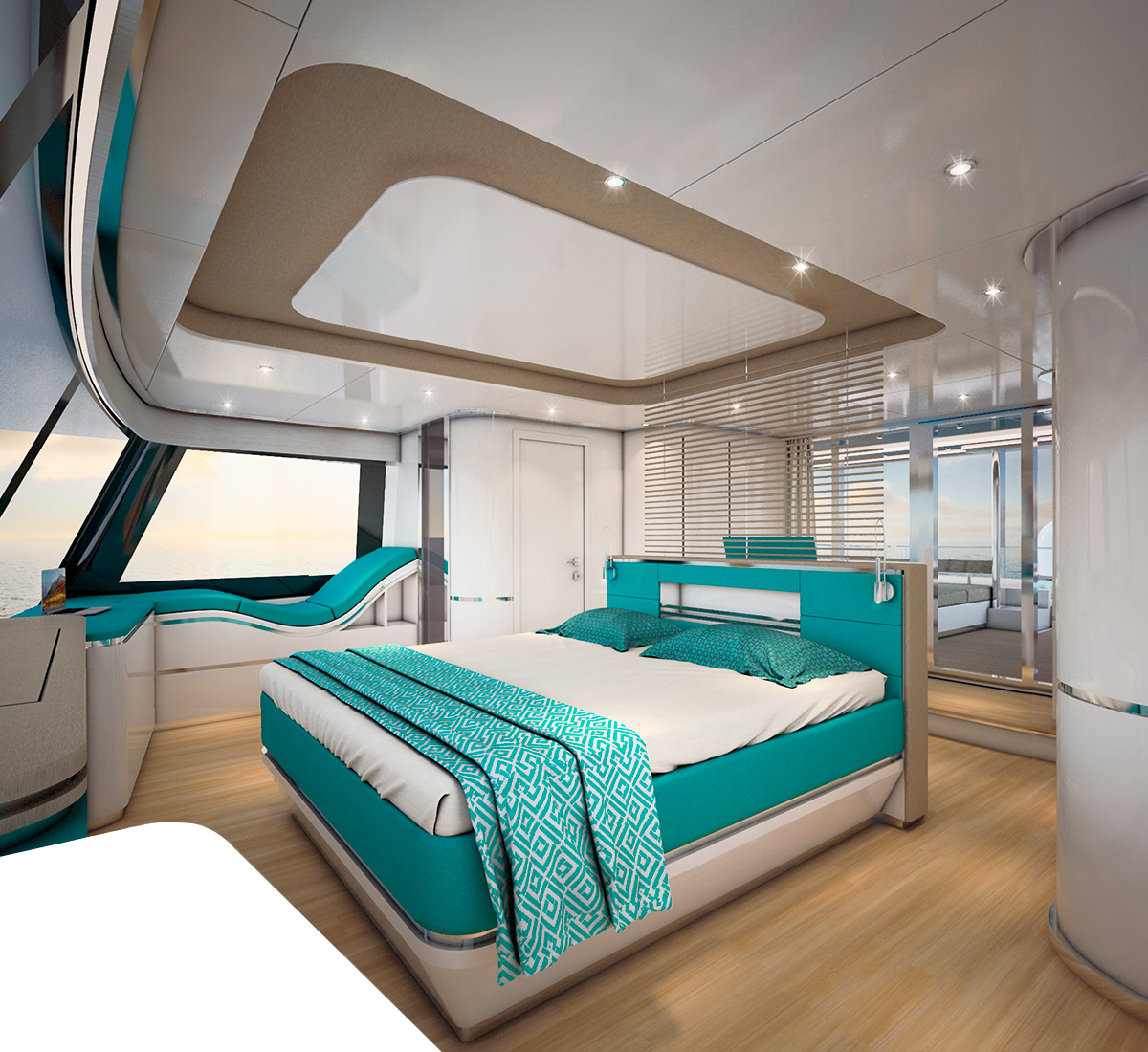
Owner'suite
The choice of an owner’s suite on the 3rd deck adds to the exclusive appeal of the Silent 80. With the entire deck measuring 80 m², it comes with an en-suite bathroom and a private terrace in the aft offering direct access to the sunbed.
If you would like to enquire about this electric yacht and get in touch with a member of our team, please click on the button below.
Other models
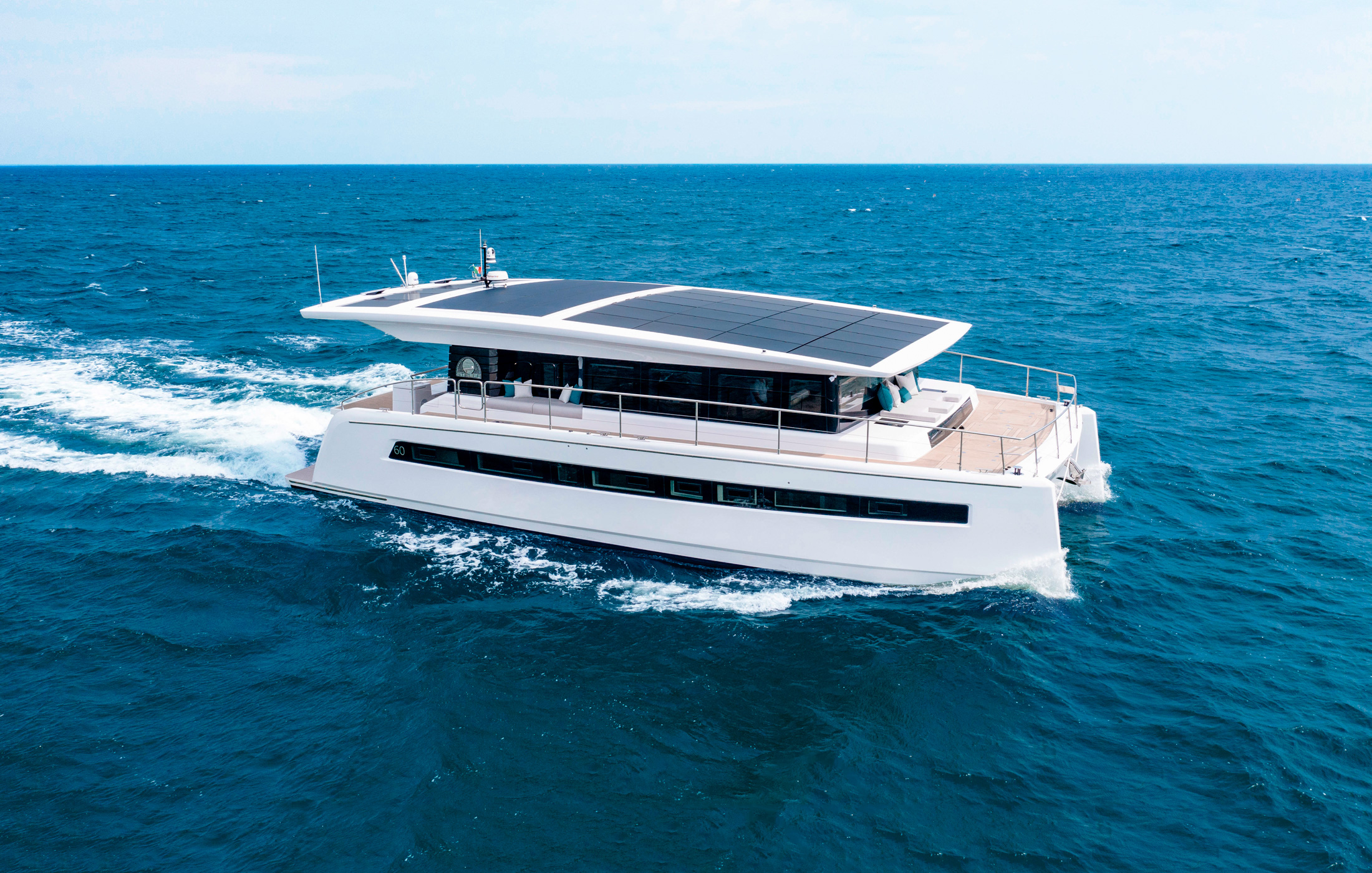
120 Explorer
New Greenline Hybrid Yachts are Tax Exempt in WA State! Call 206-659-0710 for details. Read More>

< Back to Blog
Solar Yachts, A Very Bright Idea
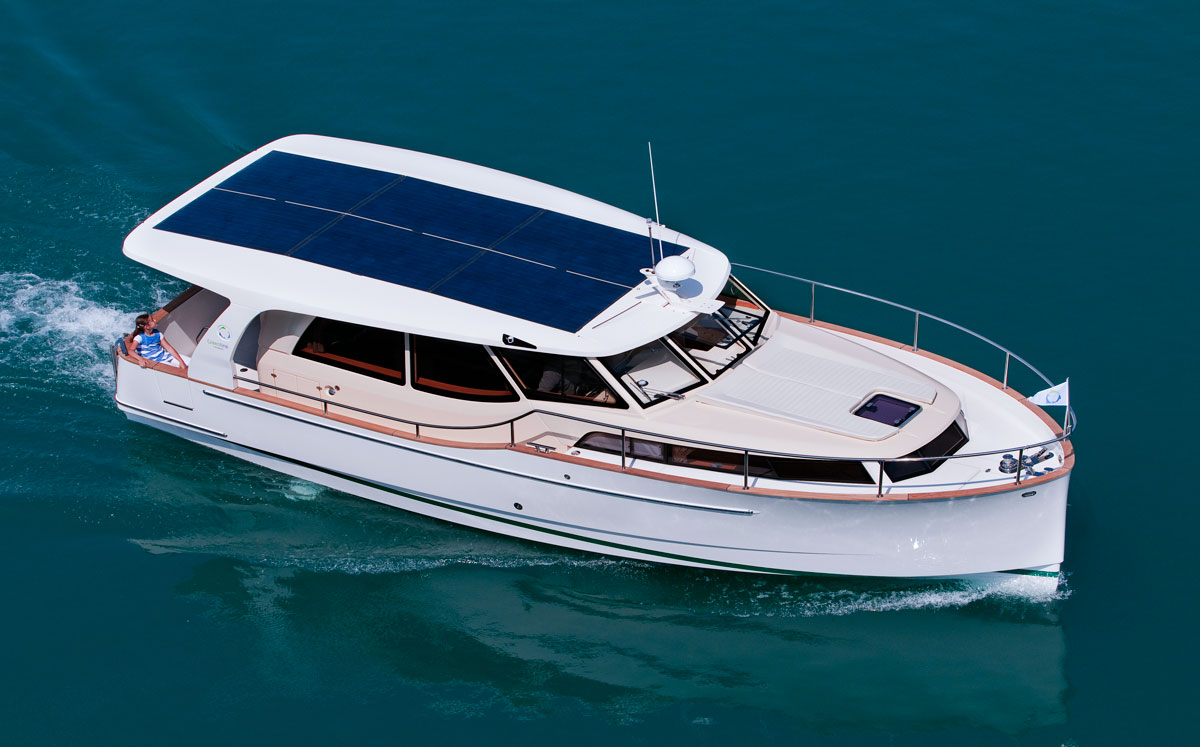
Tens of thousands of years ago, humankind discovered that standing on a log and pushing with a stick would allow a person to cross a pond or a shallow lake. The push pole evolved into an oar, and we ventured across seas and along coastlines. Some genius figured out how to sail with the wind, and we crossed oceans.
We assumed for eons that maritime propulsion had evolved to its ultimate destiny. Then came the Industrial Revolution. Over several decades, Eli Whitney invented the steam engine and Etienne Lenoir, Nicholas Otto, and Rudolf Diesel all invented versions of an internal combustion engine. Throughout the last century, either the wind or a petroleum fired mechanical engine provided propulsion for pleasure craft.
The Solar Revolution is upon us. The yachting community and the maritime industry are actively adopting the next step beyond petroleum powered propulsion. Solar yachts, vessels propelled by the sun, are showing up in ports and marinas around the world.
What defines a solar yacht?
Any pleasure vessel using electricity derived from solar panels as a primary or alternative source of power for propulsion can be considered a solar yacht. Even if there are other propulsion systems aboard, the term “solar yacht” may be legitimately used. Consider that we call a vessel with masts and a “sailboat” even though there is typically another propulsion system available. The sails are seldom in constant use. Likewise, most solar yachts are not exclusively or constantly powered with electricity generated from photovoltaic cells.
Unique pleasures of solar and electric yachting
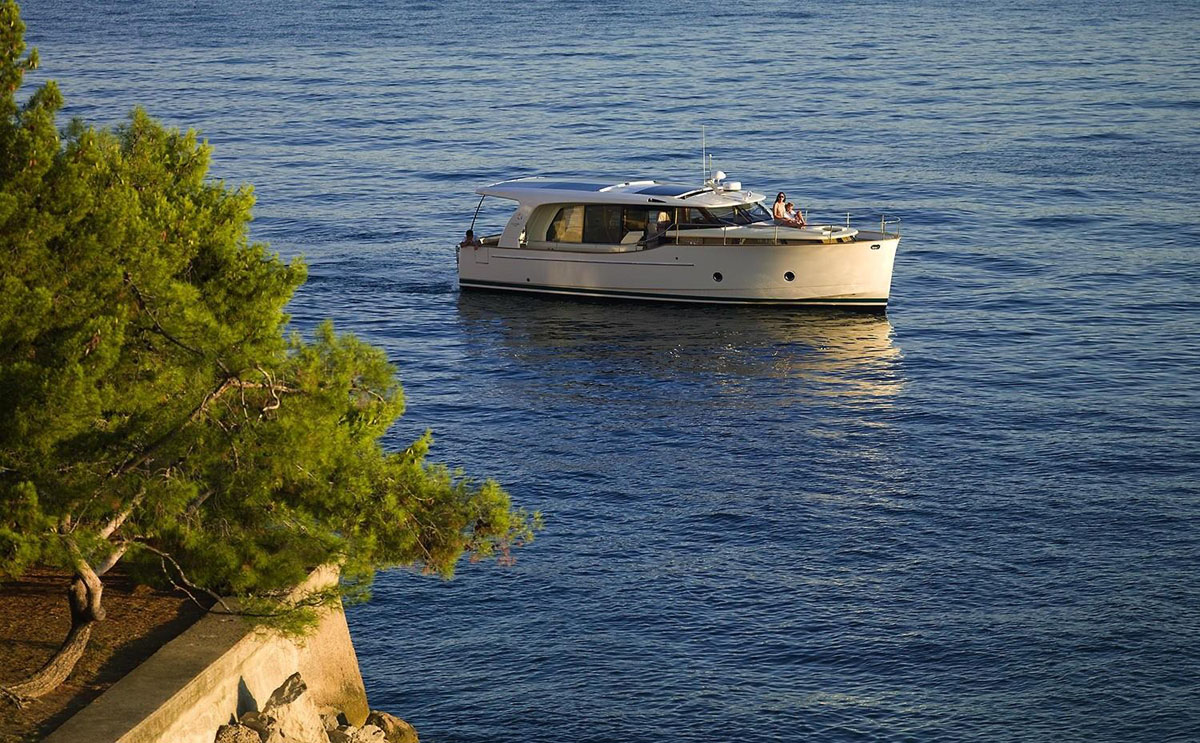
Sailors are more quickly prepared to appreciate the esthetic joys of traversing the waters at a leisurely pace. Imagine cruising where the cries of seabirds swirling overhead, the gentle slap of waves against the hull, and normal conversational tones are not drowned out by the 60, 70, or 80 decibel background drone of a rumbling diesel or thundering gasoline power plant. On an electric yacht, a shift in the wind doesn’t send everyone fleeing from the aft deck as exhaust smoke and fumes foul the air.
While a solar yacht will facilitate many happy experiences formerly reserved for sailors, there’s no need to scramble around the deck adjusting sails and rigging. No need to adapt to cruising “heeled over” at a 20 or 30-degree angle. No need to wait for the next opening of a drawbridge.
Solar yachts combine the ease of mechanical propulsion with the majesty of sail.
Limitations of solar yachts
Everything “under the sun” (pun intended!) has both advantages and limitations. The major limitations with solar powered yachts, compared with petroleum powered vessels, are range and speed. The hundreds or thousands of gallons of increasingly expensive fuel aboard a petroleum powered yacht provide a predictable, and often long range. The range comes at definite and measurable cost, as even moderate cruising speeds can burn more 3, 4 or more gallons per nautical mile. (One might observe that under sail range is unlimited- at least on those days when the wind is cooperating).
Very few builders are producing yachts relying exclusively upon solar power. Such vessels are recognizable by an oversized array of panels. Critics compare their appearance to an aircraft carrier defined by a huge flight deck, or a “floating solar farm.” The larger the square footage exposed to sunlight, the greater potential for electric power- but at some point, the sheer size becomes unworkable in close quarters and sea-keeping characteristics can radically change. Even with a 100% solar design, speed and range limitations remain.
According to leading scientific experts, the sun doesn’t shine at night. Just as sailboats rely on alternative power when the wind isn’t blowing, solar yachts will require an additional source of propulsion to allow operation after dark.
Solar yachts and current technology
Solar voltaic technology is rapidly advancing, but it’s likely that the industry remains decades away from any breakthrough technologies that will provide a 100% solar yacht with range and speed options comparable to contemporary petrol-powered vessels.
Fortunately, hybrid technology facilitates combining the benefits of solar yachting with the greater speeds and longer ranges of yachts powered solely by internal combustion engines. Everyone is familiar with hybrid technology in use by automobiles. Electric motors operate the vehicle at slower speeds, with an internal combustion on standby for longer distance and higher speed driving. The automotive and marine approaches to “hybrid” power are similar.
The largest commercial ships normally rely on a "serial" system, which uses diesel-driven generators to create electricity to energize motors turning the propeller shafts. In contrast, smaller vessels and private yachts use a “parallel” hybrid system, which uses two or more methods of propulsion to turn a prop shaft. Hybrid redundancy provides a margin of safety and convenience. Should one propulsion system fail for any reason, there’s “backup” available so a vessel can remain underway. Most solar yachts are configured as hybrids, with electricity from solar panels used to recharge batteries powering electric motors.
Greenline solar hybrid yachts

Greenline Yachts is the acknowledged leader in the solar hybrid yacht industry. While many builders have solar and hybrid powered boats “on the drawing board,” Greenline has launched more than 600 premium-quality vessels since establishment in 2009.
Greenline’s approach to solar yachts includes the reasonable and aesthetically pleasing use of solar panels on the upper surfaces of their boats. Energy from the photocells is transferred through a converter-charger to a large bank of lithium/ion batteries below decks- occupying the space where one would expect to find the large engines and fuel tanks on a petrol- powered yacht.
Greenline resolves speed and range considerations by employing small diesel engines driving the same shaft as the electric motors. Like the automotive application, the electric motors manage the slow speeds, and the diesel engines are called upon when higher speeds are desired. When the internal combustion portion of the hybrid system is in use, it provides an elevated level of DC power to quickly and efficiently recharge the storage batteries.
Solar cruising is now a reality
Greenline Yachts specify that their solar hybrid vessels can travel 20 nautical miles, up to 6 knots (sailing speed) without engaging the diesel-powered portion of the system at all. With an optional expanded lithium battery bank, a range of 40 nautical miles can be achieved. Many boaters who are not in a particular hurry to “get there” will discover that a 40 nautical mile range is more than adequate for local excursions on summer evenings, or even a weekend cruise to a nearby park or marina.
Most pleasure boaters spend more time on the water during the summer months. Days are much brighter and longer. More solar energy is available to rapidly recharge the batteries and extend the range of a solar yacht.
Solar yachts used primarily for cruising from one marina to another have access to an already existent charging network- the shore power pedestal at every slip. Lithium batteries charge in about half the time of old-fashioned lead/acid batteries. Lithium batteries can be discharged further, additionally extending range.
Solar yachts can enhance the experience when cruising to remote locations. Many docks at destinations in northern BC and Alaska, for example, have no shore power. Solar panels will keep the battery banks topped off to provide lights, refrigeration, and other essential needs no matter where one chooses to dock or anchor. No need to disturb the peace and tranquility by firing up a noisy generator.
There is, however, one destination that solar hybrid yachts won’t visit with any remarkable frequency: the local fuel dock.
For Additional Information
A highly select network of about sixty dealers, worldwide, represent Greenline hybrid yachts. In the Pacific Northwest, Ocean Pacific Yachts represents the line from their offices in Seattle, Washington. Contact us at 206-659-0710 for more details and to schedule a sea trial. Our sales team is considered an authoritative resource for answers to general questions about hybrid yachts and electric yachts.
EXPLORE GREENLINE HYBRID YACHTS FOR SALE
Greenline 39.
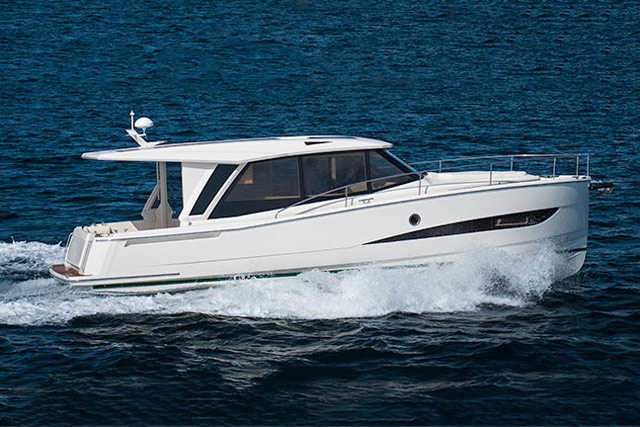
GREENLINE 40
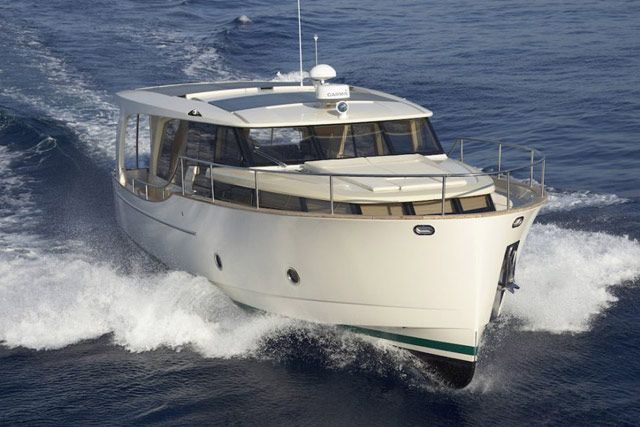
GREENLINE 45
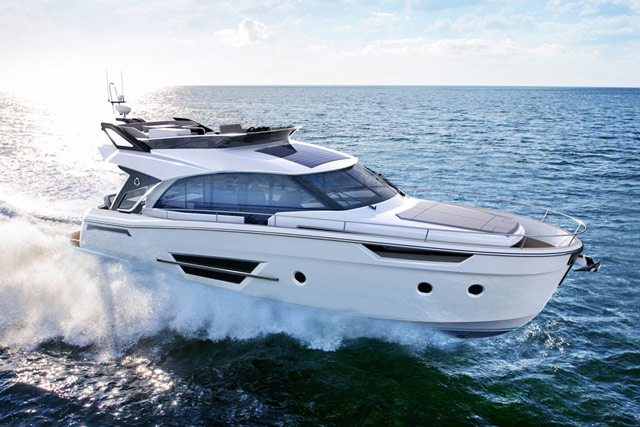
GREENLINE 48
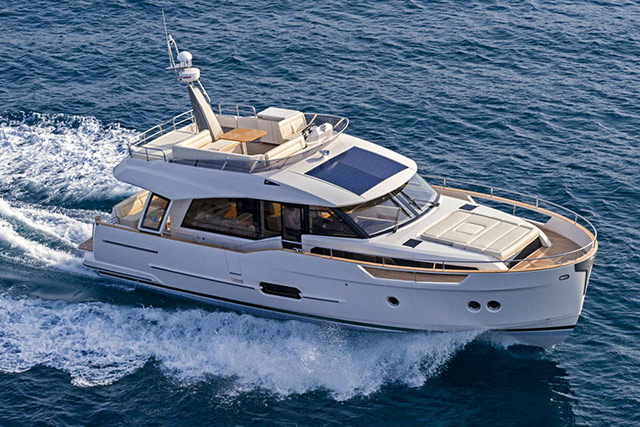
GREENLINE 58
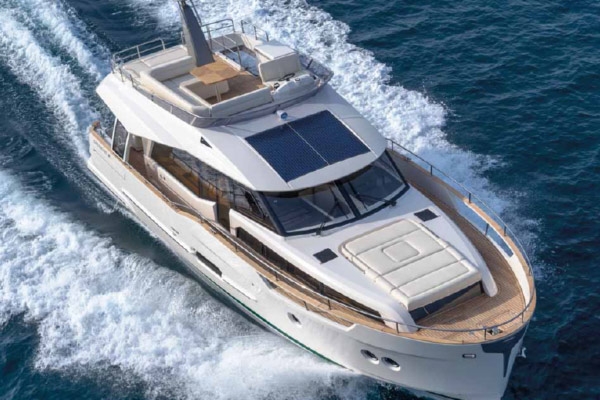
- Solar Yachting
- All Charter Companies
Boat statistics
The most detailed analysis of this charter company's yachts
Our yacht fleet
Rent a boat, sailing yacht or catamaran for the best prices online Click on the card to view different charter types.
Boats in our offer
For the best seasonal offers, take a look at the available boat deals from charter companies sorted by discount. Click on the button to view different dates and boat models.
Useful contacts
If you need to charter a boat or get a quote for a yacht charter, contact us

Phone: +420 222 528 222
Email: [email protected]
Other charter companies
You might be interested in.
- Yachting Monthly
- Digital edition

How to improve power management on a yacht
- August 21, 2024
Mike Morgan offers advice on how to improve power management on a yacht and preserve precious amps for those that like their home comforts

I confess, I’m not a marine electrician, and my understanding of boat electronics is at best rudimentary, but I’ve now been managing my boat’s power generation and consumption for three seasons and have developed an approach which seems to work well. Hopefully, you will find some of the following advice useful when it comes to managing your own yacht’s energy needs.
Every boat has its own particular balance of power generation and demand, so my system may not work perfectly for you, but it might help you start managing your precious amps a lot more effectively.
My wife Debbie and I sail up to nine months a year around the Med, predominantly lying at anchor. We avoid marinas and use our generator infrequently, to help save the planet and our budget.
I won’t address power needs whilst under sail here, as it’s not relevant to our cruising profile. Clearly, if you’re taking on an Atlantic crossing , then you’ll need to consider the power demands from your navigation equipment, lights and auto pilot.
We bought our pride and joy, Spirit, a Bavaria C57, brand new in 2021, and made several upgrades in an attempt to achieve the holy grail of self-sufficiency at anchor. We opted for 800 amp hours (Ah) hours provided by lithium batteries that weigh less than a single 150Ah lead acid battery.
Because lithium offers roughly twice the capacity of lead acid, that’s equivalent to 16 100Ah lead acid batteries with a combined weight of just over a third of a ton. Given Spirit’s generous beam, we’ve been able to accommodate four 420W solar panels, giving a potential maximum of 1,680W.

A few of the electrical galley appliances aboard Mike’s Bavaria C57 and the wattages that similar products might draw off your battery if you have an inverter
State of charge
The amount of electrical power you have available is all about batteries. Boat batteries are usually measured in amp hours (Ah) – the total number of amps devoured in one hour of use. So, a 120Ah battery will, theoretically, deliver 120A for one hour or 1A for 120 hours. But, of course, this is a little simplistic.
If you have lead acid batteries, you must never completely discharge them, unless you want to replace them regularly. Lead acid batteries should never be discharged below 50 per cent, so the practical Ah they really offer is half the theoretical Ah rating. In the above example, 60 hours at 1 amp would be the limit before you had to recharge the battery. Typically, the state of a battery’s charge is monitored by volts or a shunt battery monitor.
Knowing the state of charge of your batteries is critical to managing your power needs.
Article continues below…

How to get your yacht home without power
Electrical systems and electronics have become such an essential part of our normal lives that it’s hard to imagine life…

Everything you need to know about yacht solar power
Keeping your batteries topped up without having to run the engine is a continuous challenge for cruising sailors, especially those…
I replaced our Bavaria’s standard 240Ah of domestic lead acid batteries with 800Ah of lithium batteries. The advantage of a lithium battery is its light weight. And, unlike a lead acid battery, it can be run down to a much lower charge. The downside is that lithium batteries have been known to explode.
To avoid this, they need to be paired with a battery management system, which is best left to a professional, who knows what they are doing, to install.

Oceanvolt lithium batteries aboard a Feeling 32
Charging sources
A standard ‘off the shelf’ mid-size production boat is likely to be fitted with a 60A battery charger which is used by the boat’s generator, if it has one, or when shore power is plugged in. The engine will also have an alternator which will typically produce between 35 and 60A of charge, depending on the size of the engine.
Assuming a 60A charge source, the batteries will receive 60A of charge in one hour. So, to put it very simplistically, if you have, as I do, 800Ah of lithium batteries and they are at 50 per cent, to charge them up to capacity would take 6.6 hours (400 amps divided by the charging source of 60 amps equals 6.6 hours).
Unfortunately, it’s not quite as simple as that. For example, there are various charging states – bulk, absorption and trickle (also known as maintenance or float) – and different types of batteries with different ratings, but I have kept it as simple as possible here for the purposes of explanation.
If you don’t have shore power (when at anchor, for instance), or don’t have a generator, the alternative is to run your engine for six hours under light load, which is not good for the engine and won’t win you many friends nearby who are trying to relax and enjoy a peaceful sundowner.

Mike’s customised electrical control panel
Battery charger
Increasing the size of your battery charger will speed up the process of charging from both a generator and shore power. I opted to fit a 120A charger and a 3kW inverter for my 240V appliances. There is always the option to beef up the engine alternator to feed a hungry family of batteries, but again, this means the boat engine needs to run for prolonged periods of time.
The 9kW Paguro 9000 generator I fitted produces a lot more power than we ever need. The generator powers both the 240V ‘ring main’ and the battery charger. However, the battery charging will be limited by the power rating of the charger, which in my case is 120A.

Four solar panels on Spirit’s stern arch produce a maximun 1,600W
Renewable energy
Renewable energy for boats is either wind, hydro or solar. I opted for solar on a custom-made stern arch. I fitted four 400W panels, which produce a theoretical maximum output of 1,600W at 12V or, in amp speak, 133A.
Like lithium batteries, the voltage and charge from solar panels needs to be managed, so each panel is equipped with an MPPT (maximum power point tracking) controller to ensure the batteries are getting the right amount of charge when the sun is shining. The next conundrum was to get all this in perfect balance based on the boat’s power consumption.

The stern arch was custom-built to support the solar panels
Background noise
I started by building a spreadsheet to calculate the various power ratings of my many onboard electrical appliances. However, this isn’t simple as you must calculate the power demand of each appliance, estimate how long you will run it for, and when you will run it.
You then need to map this over time to calculate a theoretical power demand and how much power you need to be generated. Estimating the power output from my solar panels alone became a headache: calculating the assumed number of ‘sunny’ daylight hours, the angle of the sun, solar panel efficiency, and when the next solar eclipse would be! So, like all people with limited brain capacity, I gave up.
I decided, instead, to take a more pragmatic approach. The first thing I did was to measure the ‘background noise’ of my boat; that is, the power being consumed whilst at anchor and not running any major appliances.
It turned out to be around 200A, which is very high; but then I do have three fridges, a deep freeze and more internal lighting than Blackpool Illuminations.
The time it takes to recharge my batteries once the sun has dragged itself up to the right angle differs dramatically based on which way the boat is lying. If my stern is exposed to the sunny side my batteries will fill to the brim in a few hours. However, if my bow is facing the sun, it takes a lot longer.
On an average day, we are at 100 per cent by midday or early afternoon, leaving a good four or five hours of surplus power generation for running more critical systems.

Air-con is a battery power ‘killer’
We have a lot of power consuming paraphernalia on board, for example the kettle, coffee maker, hair dryer, microwave oven, and so on, but I ignore these when it comes to power management as they are used randomly and are never on for long.
However, we do have several appliances that are critical to our power management, including a washing machine, water maker, ice maker and water heater. All of these have high demand and can run for long periods of time. I also have air-conditioning which can be run off the inverter, but I prefer to use fans and open hatches to keep the temperature tolerable when we are at anchor. Air-con is a battery power killer and is best left to when shore power is connected or the generator is running.

Our Bavaria came with a built-in utility room, so we decided to fit a full-sized washer-dryer, which has proven to be our favourite upgrade.
For this equipment I simply use a rota and allocate a specific day to run either water production, laundry, ice making or water heating. We do laundry once a week without using the drying function and relying instead on nature’s outside dryer, which does tend to lower the tone of an idyllic anchorage.
The water maker produces 60 litres an hour and I typically run it for around four hours, which will then keep us going for several days. I fit in ice-making and heating the water at other times.
Having guests on board who insist on having a shower every time they go for a dip off the swimming platform requires the water maker to be run most days. Inevitably under these circumstances I lose the battle of consumption versus generation and will need to resort to running the generator.

We chose a Schenker Smart 60-litre-per-hour, 12V water maker rated at 20A, which enables free freshwater production all day long thanks to Spirit’s cluster of four solar panels.
I always delay this until my battery charge is showing 30 per cent or less in the morning. At that point I will run the generator for three to four hours, which is enough to get my batteries back up to around 70-80 per cent, and then let the solar panels take over.
When I run the generator, I take advantage of the surplus power it produces by running as many devices as possible: I make water, run the air-con and heat water. Never waste any of those precious amps! I find that I run the generator, on average, every eight to 10 days when we’re on our own and every four to five days when we have guests.

Batteries can be easily distributed around a yacht
Before increasing the capacity of your service battery bank you need to calculate your total power requirement by multiplying the amperage of all the equipment by the period of time it will be run over a charge cycle (usually 24hrs).
Tally up the amp hours and then double the result (to allow for not going below 50 per cent of your charge capacity). Then add another 20 per cent to ensure you will always have enough to spare.
If you already have separate engine start and service batteries but want to add further service batteries, they should all be of the same age, type and capacity (Ah rating) to the first. It’s best to create your service bank from a number of smaller batteries and then link them together to achieve the total voltage and capacity you require.
If you’re planning to install a large bank (500Ah or more), it is often better to use 6V cells for this as these allow a large deep-cycling bank to be created, while still having the ability to move them around easily or distribute them evenly over a greater area.

Create an improved service bank by connecting a number of smaller batteries
Stay in charge
Once you’ve decided on the battery type, make sure you have enough charging power to fully charge them between cycles. As a rough guide you will need to be able to bulk-charge the bank at a minimum of 10 per cent of its rated capacity (ie. 20A for a 200Ah battery).
However, 20 per cent is a better figure to aim for if you’re looking to fully recharge over one night in a marina. Modern AGM (absorbent glass mat) style batteries can usually take a greater charge than wet lead-acid type, although gel cells require a more particular regime if they are not to be damaged.
Chargers (both mains and alternator regulators) should be of the multi-stage type, with bulk, absorb and float stages. This allows the batteries to be rapidly charged until they reach around 90 per cent charge, then the charge voltage drops to attain the final part of the charge more slowly, keeping temperature (and hence internal resistance) down, and eliminating gassing.

A smart battery monitor will allow you see your state of charge and remaining capacity
Temperature noticeably affects a battery’s ability to give out and absorb charge. The colder a battery gets, the greater the power required to charge it fully. For this reason, always fit a charger or regulator with a temperature sensor that will automatically compensate for these differences.
Most power devices produce a trickle charge, and are used to keep the engine battery topped up. However, if you’re planning to install a powerful (5A+) wind or water generator, or a large solar array, then you’ll need to install some sort of voltage regulator to prevent overcharging. This can vary, from a small solid-state switch for small solar panels, to a large dump resistor that dissipates excess charge from a wind generator through heating up a wire-wound resistor.
Monitoring your batteries
The easiest way to ensure your batteries are kept in tip-top condition is to observe their state of charge every day you’re on board, using a modern ‘smart’ battery monitor. This will give you a real-time display of the current going in and out, the state of charge (SOC), and the remaining capacity available. They also often have alarms to warn you when the voltage is dropping dangerously low, or if too high a charge is being applied.
A rough idea of the SOC can be attained using a voltmeter, but this is not particularly accurate and can indicate a false condition when recently charged or under a heavy load. It’s far better to install a monitor that has a shunt, which measures current flow over time and can calculate the available charge capacity remaining much more precisely.

Hydrogenerators, like this Remoran Wave 3, will quickly recharge a yacht’s batteries underway
Optimising solar power
The efficiency of solar panels can be compromised by saltwater and long-term exposure to UV and high temperatures. Good regular maintenance will improve a solar panel’s performance.
Clean your solar panels early in the morning, while they are at their coolest, as cleaning them when they are warm or exposed to direct sunlight can cause internal thermal stresses.
Use distilled or deionized water to avoid the formation of mineral stains or deposits on the surface of the panels, and avoid using harsh chemicals or abrasive solvents that could scratch the photovoltaic cells. Let the panels air-dry or use soft cloths, and make sure no water residue is left. Check regularly for cracks, breaks or loose connections.
Hydrogenerators
Hydrogeneration has become a great deal more efficient in recent years. It’s a very simple concept: the yacht’s motion through the water turns an alternator on the transom-mounted hydrogenerator which generates electricity to recharge the boat’s batteries. Achieving 300Ah each day is a realistic expectation when cruising at 7-8 knots.

Oceanvolt’s High Power ServoProp 25 electric saildrive
Main prop regeneration
You can also use your main propeller to ‘regenerate’ electricity whilst under sail by using a parallel hybrid propulsion system where an electric motor is installed alongside the engine. Lynch Motors in Devon has supplied its systems to Vendée Globe boats for years, purely as a re-generator, and now produces a Red Snapper electric motor for cruising yachts.
The only problem with a regeneration system is that the pitch required for the propeller to drive the boat efficiently through the water may not always be the same as the pitch for optimum regeneration. Manufacturers have tackled this in different ways.
Oceanvolt has developed its ServoProp for saildrives, which electronically adjusts its pitch depending on speed and function. The latest incarnation allows total 360° blade mobility and faces forwards, increasing efficiency: at six knots, it produces an eye-watering 1kW of power.
Bruntons has another solution with the cleverly engineered Autoprop, which automatically pitches up to match the boat speed. Its Ecostar version of the prop can generate 200W at five knots and up to 1kW at 10 knots when connected to an electric motor.
Enjoyed reading this?
A subscription to Yachting Monthly magazine costs around 40% less than the cover price, so you can save money compared to buying single issues .
Print and digital editions are available through Magazines Direct – where you can also find the latest deals .
YM is packed with information to help you get the most from your time on the water.
- Take your seamanship to the next level with tips, advice and skills from our experts
- Impartial in-depth reviews of the latest yachts and equipment
- Cruising guides to help you reach those dream destinations
Follow us on Facebook , Twitter and Instagram.

COMMENTS
The Original Solar Yacht. As the original inventors of series produced solar-electric yachts, we pioneered this innovative approach. Our first model, the Silent 64, was launched to the market in 2016, several years before any other shipyard considered the possibility of going electric.
ALVA Yachts is an electric luxury yacht brand harnessing uncompromised design and cutting-edge technology. Our mission is to bring yachting into a new era with a product offering of progressive, electrified solar catamarans and sailing yachts that are designed and engineered without compromise.
On the smaller 55 and the 64, Silent Yachts currently recommends a 19m2 kite that costs around €25,000 - a fraction of the cost of a new mast, boom, shrouds and sails. "The sail ...
Powered by solar panels & wind turbines, our yachts give a complete autonomous range, a robust build, and an array of innovations for an optimum yachting experience. Gilles Reigner Yachts , a pioneering force in maritime excellence, defines the future of yachting by crafting Electric Catamarans powered by 100% renewable energies—harnessing ...
Everything you need to know about yacht solar power. Marine solar panels are becoming more efficient and eco-friendly. Dennis O'Neill reports on the latest design advances. Keeping your batteries topped up without having to run the engine is a continuous challenge for cruising sailors, especially those who are highly conscious of their carbon ...
The boldest expression of solar powered yachting yet. Our 120 Explorer brings Silent technology to the superyacht level. Capable to taking you almost anywhere on the water, she pushes our dedication to engineering and innovation further than any other electric yacht before. Just as with our 80 Series, Marco Casali was responsible for the ...
The blue water capable ZEN50 lightweight racing carbon hulls are combined with a huge solar roof for an unrivaled solar power vs. displacement ratio above 1:1 (18 kW / 17 tonnes), making this yacht completely energy self-sufficient. A revolutionary, fully automated, wingsail - by Ayro© - can be added as a range and speed extender.
Welcome the Soel Senses 62, a fully sustainable solar electric yacht for silent cruising with trans-ocean capabilities. State of the art technology is combined with modern design, to offer the highest comfort and pleasure on board, while providing an extremely sustainable way of cruising the oceans. With no noise distractions on board, the 62ft ...
This makes Sunreef Yachts Eco the lightest marine solar power system producer in the solar catamaran market. Each of the solar cells administered into the Sunreef solar catamarans are ISO 9001:2015 certified and offer a peak performance of ±24 percent, this is 25 to 30 percent more power compared to conventional cells.
SILENT 55 - The award-winning solar yacht. In November 2019 the SILENT 55 won the "Best of Boats Award" in the "Best for Travel" category. This special category is defined as "suitable for long-distance travel with all the amenities to live permanently on board, adapted to both inland waters and the harsh conditions at sea". ...
Being able to design the 60 Series with an exclusive owner's suite on the 3rd deck us unique amongst 60-foot catamarans. The suite itself is fully equipped with an en-suite bathroom and measures 23 m² in size. It also gives direct access to the 36 m² lounge area in the aft. If you would like to enquire about this electric yacht and get in ...
The perfect mid sized electric solar catamaran. The OCEAN ECO 60 is an innovation packed solar assisted electric long-range cruiser that will perfectly suit customers who like to cruise and explore while yachting.Designed with luxury, safety and cruising comfort in mind, it is an example of the latest technological developments in the field of self-sufficient yachts surpassing its competition ...
The Serenity 64 has 65 square meters of SunPower® solar panels and can cruise indefinitely at 4 to 6 ...[+] knots. Serenity Yachts. With new fully electric and hybrid boats, the yachting industry ...
Solar Boats Summary - Solar Catamarans, Yachts & Superyachts. If you are an advocate of sustainable yachting or sustainable tourism and are looking to buy an eco-friendly boat that doesn't rely on fossil fuels, then you would do well to consider getting a solar catamaran.In this article, I will go through the pros and cons of 10 of the best solar yachts and superyachts that you can buy in ...
The SoelCat 12 is an energy autonomous solar electric boat, designed from the ground up as a fully sustainable excursion vessel to enjoy the sea. The solar catamaran brings true eco-tourism to water-bound operators, communities, resorts, lagoons and nature reserves. With no CO2 or noise emissions involved, we can save the ocean and offer a ...
THE AVAILABLE SPACE. In practical terms, a modern 40ft monohull would have the space for around 1,200W of PV panels (cockpit arch, sprayhood top, deck), maybe 1,500W with the addition of a few portable panels for use at anchor. The 1,200W of fixed position solar array could produce around 360Ah on a sunny summer's day (zero shading) or more ...
MASTERFUL DESIGN MEETS SOLAR YACHTING. The OCEAN ECO 78 is an innovation packed solar assisted electric performance catamaran that will perfectly suit customers who like to cruise and explore while yachting. Designed with luxury, safety and performance in mind, it is an example of the latest technological developments in the field of self ...
Silent Yachts currently offers three solar-powered power catamaran models including the Silent 55, Silent 64, and Silent 80. United Yacht Sales is proud to be the U.S. distributor for Silent Yachts and can assist you in your search for the world's first solar-powered yacht. For more information, please contact United Yacht broker Darren Sell at ...
Would you rather have a solar powered yacht or a sail boat? Chasing the wind or the SUN?! ☀️⛵️🤔 Thank you Silent Yachts for hosting us!!! :) https://www.sil...
More spacious, bolder with premium levels of elegance and comfort. The 80 Series combines our state-of-the-art solar electric drivetrain with unmatched refinement. Her timeless exterior and modern interior features bespoke design by none other than renown Italian yacht designer Marco Casali. Highly advanced hydrodynamics make for an incredibly ...
In the Pacific Northwest, Ocean Pacific Yachts represents the line from their offices in Seattle, Washington. Contact us at 206-659-0710 for more details and to schedule a sea trial. Our sales team is considered an authoritative resource for answers to general questions about hybrid yachts and electric yachts.
Giosolar 1,000W flexible solar panel. Best flexible boat solar panel. Delivering a mighty kilowatt of power, (not far off the amount used by a one bedroom house), this Giostar package comprises ten separate 100W panels, each of which is 1,050 x 540 x 2.5mm in size. Capable of charging either 12 or 24V batteries, a kit of this magnitude is one ...
Solar Yachting currently operates 27 charter yachts in its fleet. Check availability of their boats and make an on-line reservation in yachting.com. Best price guarantee +49 211 54 69 22 23
You then need to map this over time to calculate a theoretical power demand and how much power you need to be generated. Estimating the power output from my solar panels alone became a headache: calculating the assumed number of 'sunny' daylight hours, the angle of the sun, solar panel efficiency, and when the next solar eclipse would be!